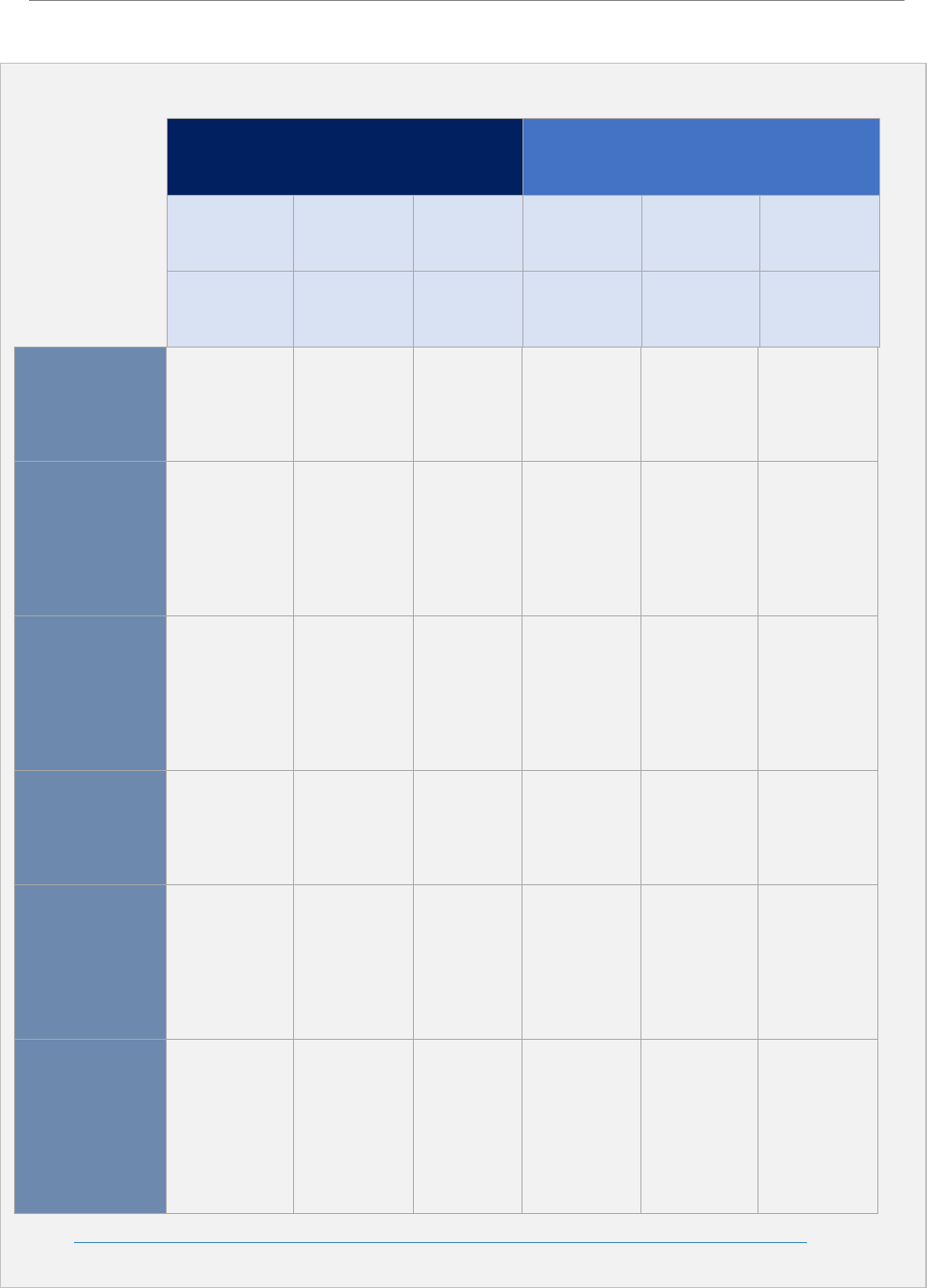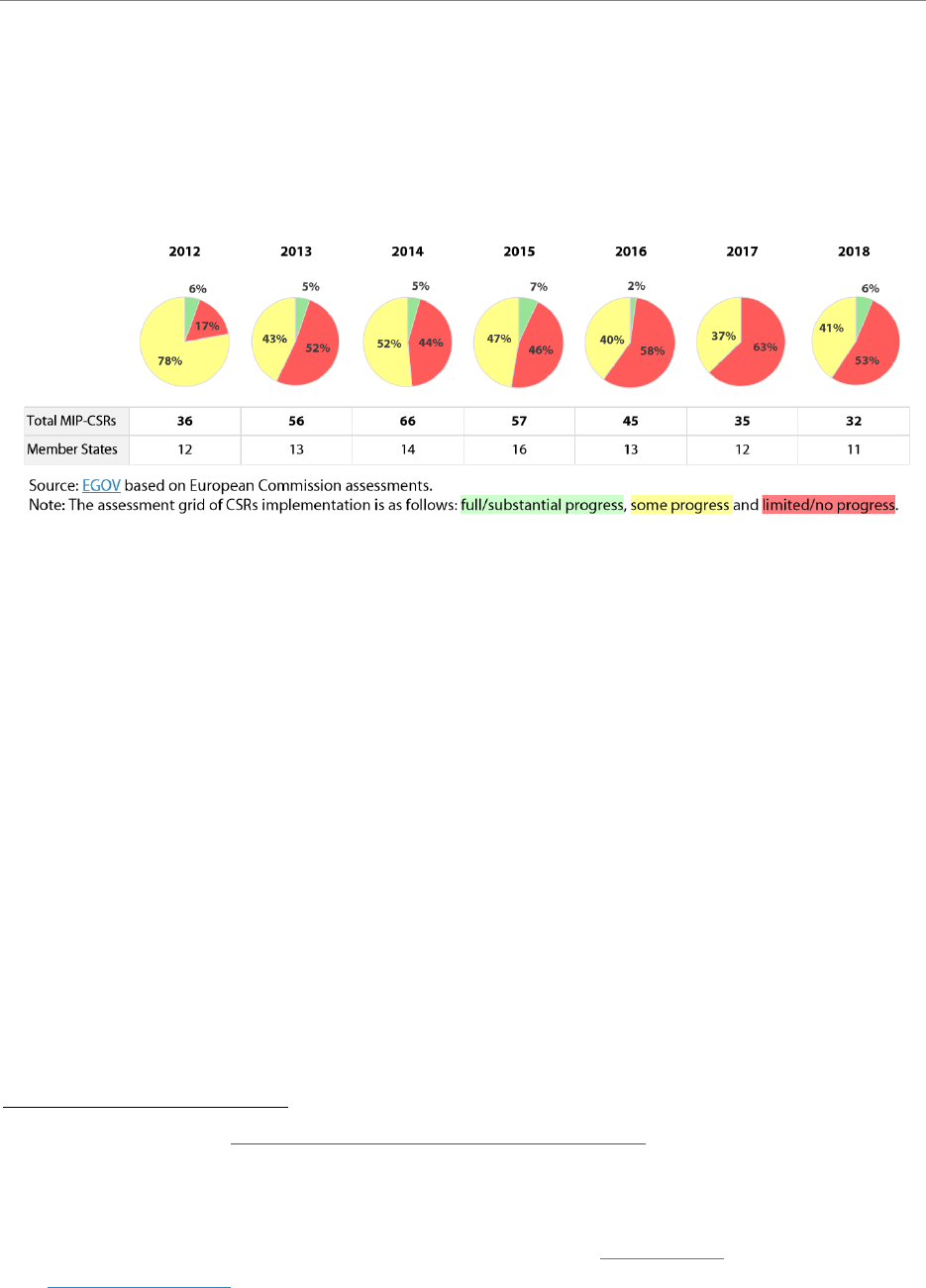
The European Semester for
economic policy coordination:
A reflection paper
Economic Governance Support Unit (EGOV)
Authors: K. HAGELSTAM, C. DIAS, J. ANGERER, A. ZOPPÈ
Directorate-General for Internal Policies
PE 624.440 – October 2019*
EN
STUDY

IPOL | Economic Governance Support Unit
2 PE 624.440
DO NOT DELETE PAGE BREAK

The European Semester for economic policy coordination: A reflection paper
PE 624.440 3
The European Semester for
economic policy coordination:
A reflection paper
Subtitle (optional)
Abstract
This paper provides an overview of the current EU economic
governance framework, in particular of the so-called EU ‘rule-
based’ surveillance framework of national budgetary, economic
and social policies. It raises some broad questions on the lessons
learned and proposes some reflections for the future.
This document was prepared by the Economic Governance
Support Unit of the European Parliament and the opinions
expressed are the sole responsibility of the authors and do not
necessarily represent the official position of the European
Parliament.

IPOL | Economic Governance Support Unit
4 PE 624.440
AUTHORS /ADMINISTRATORS RESPONSIBLE
K. HAGELSTAM, C. DIAS, J. ANGERER, A. ZOPPÈ,
European Parliament
EDITORIAL ASSISTANT
M. CIUCCI and J. VEGA BORDELL
European Parliament
LINGUISTIC VERSIONS
Original: EN *Linguistic revision in January 2020
ABOUT THE PUBLISHER
The Economic Governance Support Unit provides in-house and external expertise to support EP
committees and other parliamentary bodies in shaping legislation and exercising democratic scrutiny
over EU internal policies.
To contact the Economic Governance Support Unit or to subscribe to its newsletter please write to:
Economic Governance Support Unit
European Parliament
B-1047 Brussels
E-mail: [email protected]pa.eu
Manuscript completed in October 2019
© European Union, 2019
This document and other supporting analyses are available on the internet at:
http://www.europarl.europa.eu/supporting-analyses
DISCLAIMER AND COPYRIGHT
The opinions expressed in this document are the sole responsibility of the authors and do not
necessarily represent the official position of the European Parliament.
Reproduction and translation for non-commercial purposes are authorised, provided the source is
acknowledged and the European Parliament is given prior notice and sent a copy.

The European Semester for economic policy coordination: A reflection paper
PE 624.440 5
CONTENTS
LIST OF ABBREVIATIONS 6
LIST OF BOXES 7
LIST OF FIGURES 7
EXECUTIVE SUMMARY 8
AN EVOLUTIONARY DESIGN OF THE EMU GOVERNANCE 9
1.1. From Maastricht until today: two complementary approaches? 9
1.2 The EU and US economic governance frameworks: comparing apples and pears? 12
1.3 Some broad questions on lessons learned and possible ways forward 15
THE EUROPEAN SEMESTER AT A GLANCE 17
2.1. A rule-based coordination and surveillance framework 17
2.2. The role of the Country Specific Recommendations 19
3. SOME REFLECTIONS ON THE EUROPEAN SEMESTER FRAMEWORK IN GENERAL 21
3.1. What relationship between policy objectives and underlying tools? 21
3.2. A reinforced EU coordination framework for sustainable growth and jobs? 21
3.3. Specific policy instruments aiming at preventing unsustainable policies inside the monetary
union 23
3.4. How to go beyond the rules in the Semester framework? 24
4. THE FISCAL SURVEILLANCE FRAMEWORK 27
4.1. A detailed EU rules-based fiscal surveillance framework 27
4.2. What are the underlying reasons for the complexity? 28
4.3. The debate on structural balances 29
4.4 The debate on pro-cyclical fiscal policies 30
4.5 The debate on simplification 31
5. THE MACROECONOMIC IMBALANCES FRAMEWORK 33
6. WHAT CAN BE CONCLUDED? 36
ANNEX 1: DEFINITION OF THE EUROPEAN SEMESTER (ARTICLE 2-A OF REGULATION 1466/2011)
43

IPOL | Economic Governance Support Unit
6 PE 624.440
LIST OF ABBREVIATIONS
CSR
Country Specific Recommendations
ECB
European Central Bank
EFSF
European Financial Stability Facility
EMU
Economic and Monetary Union
ESM
European Stability Mechanism
IMF
International Monetary Fund
MIP
Macroeconomic Imbalance Procedure
SGP
Stability and Growth Pact
GDP
Gross Domestic Product

The European Semester for economic policy coordination: A reflection paper
PE 624.440 7
LIST OF BOXES
Box 1: Why an EU-level economic governance framework? 9
Box 2: A simplified comparison of EA and US economic governance frameworks 14
Box 3: The legal basis of the CSRs 17
Box 4: The EU integrated policy guidelines 22
Box 5: The SGP in a nutshell 27
Box 6: External experts’ papers for the EP: ‘Are the current automatic stabilisers in the euro area Member
States sufficient to smooth economic cycles?’ (May 2019) 30
Box 7: External experts’ papers for the EP on ‘The simplification of the SGP’ (April 2018) 31
Box 8: The MIP in a nutshell 33
LIST OF FIGURES
Figure 1: A trilemma for EU fiscal rules 29
Figure 2: Annual assessment of the implementation rate of MIP-CSRs 34
LIST OF TABLES
Table 1: Distribution of CSRs from a legal basis perspective 19

IPOL | Economic Governance Support Unit
8 PE 624.440
EXECUTIVE SUMMARY
This paper provides an overview of the current EU economic governance framework, in particular with
a view to assessing the experiences gained from the EU ‘rule-based’ surveillance framework of national
budgetary, economic and social policies (i.e. the European Semester for economic policy coordination).
Section 1 sets out the main features of the EU economic governance framework, compares it to that of
the United States, and presents a number of topical questions. This section also notes that two
principles are inherent to the EMU governance design:, i.e. (1) fiscal responsibility lies ultimately with
the Member States (‘no bailout clause’ and ‘no monetary financing clause’) and (2) a ‘rule-based’
surveillance framework that aims at ensuring sound public finances and setting ceilings for budget
deficit and debt levels. The section also provides an overview of the evolution of these principles since
the start of the monetary union. In particular, it shows how the main principles have recently been
complemented with (1) additional EU-level governance instruments (e.g. for macroeconomic
imbalances, banking union legislation) and institutions (e.g. permanent backstop for sovereign debt,
banking supervision and resolution) and (2) the introduction of new instruments at national level (e.g.
balanced budget rules) and institutions (e.g. independent fiscal councils and productivity boards).
Section 2 provides a brief overview of the main characteristics and functioning of the European
Semester, in particular the so-called Country Specific Recommendations.
Section 3 presents a reflection on the overall design of the European Semester, with special attention
to the relationship between its policy objectives and the surveillance tools for achieving them. It poses
questions on the respective objectives and instruments that can be used to pursue a sustainable
growth strategy for the EU and the specific needs for the good functioning of the euro area.
Section 4 looks at some aspects of the EU fiscal surveillance system (the Stability and Growth Pact) and
highlights a number of questions regarding its functioning that have been raised in the public domain
and may be part of any debate on a future review.
Section 5 does the same for the Macroeconomic Imbalance Procedure.
Finally, section 6 draws general conclusions.

The European Semester for economic policy coordination: A reflection paper
PE 624.440 9
AN EVOLUTIONARY DESIGN OF THE EMU GOVERNANCE
1.1. From Maastricht until today: two complementary approaches?
The Maastricht Treaty introduced two main principles that Member States are bound to observe when
deciding their economic and fiscal policies: that the final fiscal responsibility lies with the Member
States (i.e. the ‘no bailout clause’ and the ‘no monetary financing clause’); and that of an EU surveillance
framework aimed at avoiding excessive budget deficit and debt (coupled with strict quantitative
thresholds). Since then, the latter has become the main building block of an EU ‘rule-based fiscal
surveillance system’, the Stability and Growth Pact (SGP).
The dichotomy between these two governing principles, i.e. giving the EU level the role of steering
national policies and at the same time expecting Member States to take full final responsibility
(economic, fiscal and political) for their national policies, has been part of the overall design of the
Economic and Monetary Union (EMU) since its inception. In principle, one could argue that one of these
principles should, if fully effective, be a sufficient condition for the smooth functioning of the currency
union. Nevertheless, looking at the unique design of the EMU, it was considered necessary to introduce
both these principles into the EMU governance framework as mutually reinforcing (a sort of ‘belts and
bolts’ arrangement). It is a matter of debate which of the two principles has been more effective, in
relative terms, for the stability of the euro.
During the sovereign debt crisis, both principles came under stress and their effectiveness to safeguard
the smooth functioning of the EMU was questioned. Neither of them was able to detect or prevent the
crisis from emerging in the first place and, once the crisis was installed, both principles had to adjust to
the reality in a rather flexible way. Because of the crisis, public debt levels rose dramatically in many
Box 1: Why an EU-level economic governance framework?
The institutional framework for economic policy-making in the European Union is unique. Fiscal, economic
and social policies are national competences, while the EU Treaties oblige Member States to coordinate them
at the EU level in various forms. This is, in particular, the case for the Member States that have adopted the
euro and are therefore fully sharing the single monetary policy (and currency exchange rates) inside the EMU.
This unique design is rooted in a number of reasons.
Firstly, as learned from the first decade of the single currency area, economic growth may not always be
supported by the economic fundamentals. For instance, nominal wages may develop in a way that is not
compatible with growth potential. In some cases, strong nominal growth in one country may even be fuelled
by diverging real interest rates among the participating Member States, possibly resulting in ‘assets bubbles’
in one or more Member States.
Secondly, countries inside a monetary union cannot rely on individual monetary policy and nominal
exchange rate to absorb adverse country-specific shocks, country-specific effects of common shocks, or
different country-specific economic developments. These constraints place a greater burden on other
mechanisms, such as fiscal, labour and product market policies, in their role of compensating for shocks and
facilitating adjustments. According to the IMF, in order to ensure the long-term viability of the EMU member
countries’ resilience to shocks – whether temporary or permanent – must be improved (see e.g.
IMF Staff
Discussion Note No 19/05, June 2019).
Thirdly, the importance of avoiding pro-cyclical fiscal policies (during both upturns and downturns) may be
even greater for members of a monetary union. A fiscal framework that supports the building of fiscal buffers
in good economic times could help to avoid a detrimental fiscal consolidation during economic recessions
that would undermine sustainable growth.
Finally, inside a monetary union unsustainable national economic and fiscal policies (or the absence of some
policies) in one Member State may, if not addressed in time, have strong externalities (or spillover effects) on
other Member States.

IPOL | Economic Governance Support Unit
10 PE 624.440
Member States and the ‘no bailout clause’ had to be applied in a rather pragmatic way in order to
safeguard the financial stability of the euro area.
Debates on how to reform the governance of the EMU started immediately and are still ongoing. The
unique design of the EMU governance framework has rendered it difficult to find a common vision for
a long-term ‘steady-state’ governance framework. Policies to strengthen EMU governance have instead
gone ahead step by step on various fronts
1
2
.
The first, most urgent and immediate policy response focused on crisis management. It included the
establishment of a sovereign debt backstop, namely the European Stability Mechanism (ESM) and its
predecessor, the European Financial Stability Facility (EFSF), and a more dynamic approach of the
European Central Bank (ECB) in terms of monetary policy. Those policies were complemented by clear
steps to better supervise and resolve banks inside the euro area (through the setting-up of the Banking
Union)
3
. The establishment of the ESM (and its predecessors) and the rulings of the European Court of
Justice
4
allowed providing financial assistance to a euro area Member State, under strict conditionality
and without breaching the ‘no bailout clause’.
As a follow-up to the sovereign debt crisis, the EU system for surveillance of national economic
policies has been enhanced. Today, it is a rather comprehensive framework, extending well beyond
surveillance of mere rules of public finances. The current EU surveillance framework covers numerous
policy areas, and is aimed at preventing unsustainable economic developments beyond fiscal targets,
such as those that occurred in several euro area Member States before the sovereign debt crisis. The
extent and format of this EU-level guidance - or steering framework - have evolved, depending on the
nature of the policies targeted, the most far-reaching being those for national budgetary policies.
Recently, policies aimed at also making the principle of ‘no bailout’ of a Member State’s finances
more effective have been discussed and gradually developed. These included policies aimed at
weakening the doom-loop linking sovereigns and their banks, inter alia by moving banking supervision
and resolution to the EU level (i.e. establishing the Banking Union for the euro area), introducing
‘collective action clauses’ in sovereign debt issued by euro area Member States, and emphasising the
conditionality attached to any financial assistance granted (namely by stressing the importance of a
debt sustainability analysis
5
and of ‘voluntary’ debt restructuring
6
). The possibility to introduce some
1
For an overview of the various ways to strengthen the EMU governance framework, see a previous EGOV document: ‘An
evolutionary approach to a genuine Economic and Monetary Union’ (September 2017).
2
Analysing EMU reform proposals may be complemented by a better understanding of how policies are formed during non-
crisis times at national level in relation to EU affairs, in particular euro area governance and reform. For some interesting
discussions of national policy formation in EMU in times of crisis, see the recent papers published by the EMU Choices research
project, funded by the EU under Horizon 2020: https://emuchoices.eu/
.
3
For a recent ESM discussion paper on the Banking Union, see ‘Completing the banking union to support the Economic and
Monetary Union’ (October 2019).
4
See in particular the Pringle case.
5
See, for instance, two papers commissioned by the EP on ‘Debt Sustainability Assessments: The state of the art’, by C. Alcidi
and D. Gros (November 2018) and G. Corsetti (November 2018).
6
Reforms in this direction are included in the revised draft ESM Treaty; a recent report by the chair of the High-level Working
Group on a Common Deposit Guarantee Scheme mentions further initiatives in this domain aimed at reaching a ‘steady-state
Banking Union’. See also two papers commissioned by the EP: E. Jones (May 2019) and S. Rossi (May 2019).

The European Semester for economic policy coordination: A reflection paper
PE 624.440 11
limits on banks’ sovereign debt holdings
7
and the introduction of some kind of ‘safe asset’
8
have also
been discussed
9
10
.
Enhancing the capacity at EU (or euro area) level to provide some kind of macroeconomic
stabilisation function in case of major shocks in one Member State or in several has also been
discussed. Various options have been suggested in this respect, such as a euro area budget for fiscal
stabilisation (‘rainy day fund’), funds to support national reforms and investments, and unemployment
reinsurance schemes, among others. On some of these, formal proposals have already been made
11
.
Finally, there have also been policy initiatives to introduce ‘self-imposed’ national rules and
institutions, aimed at limiting the fiscal and economic policies of the euro area Member States.
Examples of these are the contractual obligation
12
for Member States to introduce so-called balanced
budget rules into national law, as well as the establishment of independent fiscal institutions and
national productivity boards.
These various policy initiatives to strengthen the governance of the EMU do not necessarily conflict
with each other. Instead, in an optimal situation, they should aim at reinforcing each other
13
.
7
See papers commissioned by the European Parliament on ‘Sovereign Concentration Charges: A New Regime for Banks’
Sovereign Exposures’, by N. Véron (November 2017) and Y. M. Schneider and S. Steffen (November 2017)
.
8
See EGOV paper on sovereign bond backed securities for an overview of this discussion.
9
See for example the report by the chair of the High-Level Working Group on the European Common Deposit Insurance, as
mentioned above.
10
Relying on a stronger role of ‘market forces’ in the current institutional set-up of the EMU may also have its limitations, at
least in practice. On the basis of the experience of the first decades of the euro, the role that financial markets can play in
giving ‘preventive signals’ for possible unsustainable policies may have its limitations (or in some cases even be counter-
productive), due to numerous factors, such as the tendency of markets to undershoot in good economic times and potentially
overshoot in bad economic times, as well as not being very good at making a distinction between a possible liquidity problem
and an insolvency problem of an individual government inside a monetary union.
11
For budgetary support for national reforms, a budgetary instrument for convergence and competitiveness (BICC) for the
euro area and ERM II Member States on a voluntary basis and a possible instrument for the non-euro area Member States, the
Convergence and Reform Instrument (CRI), are under discussion. The CRI would aim at supporting the convergence of non-
euro area Member States towards the euro area, by providing financial support for structural reforms. The CRI would draw on
the coordination mechanisms of the European Semester, including the Country Specific Recommendations (see
letter from
the President of the Eurogroup of 10 October 2019). Furthermore, in her political guidelines as candidate for Commission
President, Ursula von der Leyen committed to proposing ‘a European Unemployment Benefit Reinsurance Scheme [which]
will protect our citizens and reduce the pressure on public finances during external shocks.’ See a paper by B. Miroslav and L,
Karolien (2017) on the ‘feasibility and added value of a European unemployment benefit scheme’. For a recent paper on
possible lessons from unemployment insurance schemes in the US, see C. Luigjes, G. Fischer, F. Vandenbroucke, October 2019:
‘The US Unemployment Insurance Scheme: A Model for the EU?’. The authors caution against an oversimplified comparison
between the American system and a possible European reinsurance scheme. However, some lessons may be learned from the
US experience.
12
This obligation stems from the so-called ‘Fiscal Compact’ (the Treaty on Stability, Coordination and Governance in the
Economic and Monetary Union (TSCG)), an intergovernmental agreement aimed at introducing a balanced budget rule in
domestic legal orders. Out of the 25 Contracting Parties to the TSCG, 22 are formally bound by the Fiscal Compact (the 19 euro
area Member States plus Bulgaria, Denmark and Romania). It was formally concluded on 2 March 2012, and entered into force
on 1 January 2013.
13
Many proposals have been put forward by academics and EU institutions to establish a comprehensive ‘roadmap’ for EMU
reform. For instance, the Five Presidents’ Report on completing the EMU of June 2015 suggested a road map covering the
following policy domains: ‘Towards an Economic Union’, ‘Towards Financial Union’, ‘Towards Fiscal Union’ and ‘Democratic
accountability, legitimacy and institutional strengthening’. A paper by seven French and seven German economists on
‘Reconciling risk sharing with market discipline: A constructive approach to euro area reform’ (CEPR January 2018) argues that
market discipline and risk sharing should be viewed as complementary pillars of the euro area’s financial architecture, rather
than as substitutes. For instance, the authors argue: ‘Creating such incentives requires a credible application of the no bailout
rule of the European treaty. Countries with unsustainable debt levels should not expect, and not be expected, to receive fiscal
assistance – whether through the European Stability Mechanism (ESM) or any other mechanism — unless they restructure
their debts. But this requires an environment in which debt restructuring becomes feasible without large collateral economic
damage. In turn, this necessitates more effective euro area-level protection of the viable part of the financial sector, re-walls,
stronger macroeconomic stabilisation, more predictable liquidity support when needed, and more risk sharing – through both

IPOL | Economic Governance Support Unit
12 PE 624.440
In order to complement the overview of the EU economic governance framework, the following section
provides a simplified outline of the ‘economic governance framework’ in the United States (US)
compared, in particular, to the euro area (EA). The objective of the comparison is to better frame the
uniqueness of the EMU design and facilitate a broader discussion in relation to its reform agenda.
1.2 The EU and US economic governance frameworks: comparing apples
and pears?
In the US, there is no ‘American Semester for economic policy coordination’ covering the economic
policies of the constituent States, nor is there an ‘American Stability Fund’ to act as a possible backstop
for individual states in times of crisis (see Box 2 below). Why not? There are many institutional
differences between the two systems, and the obvious one is that the US is a federal country, while the
EU is not. That, in turn, has many consequences for the design and functioning of the economic
governance framework
14
15
.
In the US, a supranational (centralised, or in the US terminology, federal) surveillance of the constituent
states’ economies may not be warranted because of the relative size of the public sector at the state
level, including outstanding debt stock. On average, state and local level budgets in the US account for
around 15-25 % of GDP (average in 2016: 19.8 %), while in the EU national budgets range from 26 % to
56 % (the average in the euro area in 2018 was 47 %). The aggregate US budget (federal, state, and
local) amounts to around 36 % of US GDP. In other words, half of the total public budget is controlled
by the federal level, and half by the state and local level. Therefore, potential ‘contagion effects’ from
one state to another may be less severe (than in the euro area) in times of distress in a specific state.
This is also due to the fact that the federal government has direct taxation rights and provides some
public services, both directly to US citizens (e.g. defence, foreign affairs, and to some extent justice) and
indirectly through federally funded programmes. Due to the division of taxation rights between state
and federal levels, the use of debt financing is very different in our two cases. The aggregated public
debt level for EA Member States was 85.1 % of GDP in 2018 (ranging from 8.4 % in Estonia to 181 % in
Greece), while the aggregated public debt level of the US states was 14.6 % in 2018 (ranging from 4.6 %
in Wyoming to 23.5 % in New York). In the EA, the supranational debt level is minimal (the EU budget
is not allowed to be in deficit), while in the US the federal debt level is around 104.2 % of GDP.
Moreover, in the US the states act as sovereign entities, with their own financial/budgetary
responsibilities, as defined in the US Constitution. The common understanding, based on historical
experience, is that the federal level (or another state) should not ‘bail-out’ a state in distress. Instead, a
state is expected to save in economic good times (e.g. via rainy day funds) and to adjust its expenditure
to revenue, or else to obtain extra funding from the markets in times of distress. This has also implied
major economic and social consequences for the states concerned. Nevertheless, some services
provided by the federal level would be guaranteed even during times of distress
16
. The Federal Reserve
private and fiscal channels.’ Recently, Mario Draghi wrote (October 2019): ‘All this should make it clear that deepening public
insurance by completing the banking union and strengthening fiscal union is not about creating a transfer union. It is about
creating a euro area in which there is less need for public risk-sharing in future, because we have the instruments in place to
stabilise crises more quickly, and because we have the right framework to allow private sector risk-sharing to develop more
sustainably.’
14
In some respects, one can argue that the objective of the EU economic governance surveillance framework is to be a
surrogate for federal economic and budgetary policies.
15
See also: ‘Fiscal rules in the euro area and lessons from other monetary unions’, by N. Leiner-Killinger and C. Nerlich (ECB
Economic Bulletin, Issue 3/2019).
16
In early 2009, the US Congress adopted an American Recovery and Reinvestment Act (ARRA) with the purpose of stimulating
the national economy. As part of that legislation the federal government provided USD 223 billion for three years of fiscal

The European Semester for economic policy coordination: A reflection paper
PE 624.440 13
(FED) does not have the right to buy or keep bonds issued by the states on its balance sheet (only bills
with a maturity shorter than 6 months)
17
. This means that the FED cannot play a lender of last resort
role for the individual states. This has the advantage that, in case of a possible default by a single state,
the financial consequences for the FED would be very limited. Again, this feature of the US system is a
consequence of the federal governance structure of the country. The FED uses Treasury bonds issued
by the federal government for its monetary policy interventions. Furthermore, one may notice that the
federal government bonds attract a 0 % risk weight in banks’ supervisory/regulatory rules, while
individual states’ and municipalities’ bonds are 20 % risk-weighted in the US’s implementation of the
Basel 3 Accord
18
.
Furthermore, the implicit link between the states’ budget and the financial sector is smaller in the US
than in the EA, and has therefore potentially fewer financial consequences for an individual state during
a financial crisis. In the US, capital markets also play a bigger role in the intermediation between
creditors and debtors, and thereby in private risk sharing, and the federal institutions play a stronger
role in supervising and cleaning up banks (and providing deposit insurance). In the EA, the Banking
Union is making progress in this direction.
The above-described specific features of the US governance structures limit the potential systemic risk
in the US as a whole in the case of financial distress in one or more states.
relief for state and local governments in support of core state services. See R. P. Inman (June 2010): ‘To get money into the
national economy, the federal government must use existing government agencies and government programs. States are effectively
federal “agencies” for the purpose of spending federal money, and education aid to states, Medicaid funding, and highway
construction grants are three prominent federal programs. Education aid is the most important component of ARRA assistance
called “stability aid”. Together these three spending categories – stability, Medicaid, and highway aid – account for just over two-
thirds of all state ARRA funding’.
17
See J.F. Kirkegaard (2015) on ‘Economic Governance Structures in the United States’.
18
See https://www.fdic.gov/news/news/financial/2012/fil12027.html#cont.

IPOL | Economic Governance Support Unit
14 PE 624.440
Box 2: A simplified comparison of EA and US economic governance frameworks
EA US
Supranationa
l instruments
Supranational
instruments
National
level
Supranation
al level
Supranational
level
State
level
Targeting
supranational
policies
Targeting
national policies
Targeting
national
policies
Targeting
supranational
policies
Targeting
national policies
Targeting
national
policies
Surveillance of
fiscal and
economic
policies
(‘prevention’)
N.A.
Yes
(European
Semester)
Yes
(‘balanced
budget
rules’, ‘IFIs’)
No No Yes
(‘balanced
budget rules’;
‘rainy day
funds’ )
Fiscal policy
(provision of
‘public goods’,
‘transfers’ and
‘stabilisation’)
No/Limited
(only the EU
budget)
N.A.
(only ‘EA
recommendatio
n on the
aggregated
fiscal stance of
the state’)
Yes
(rather
large, but
often pro-
cyclical)
Yes
Yes Yes
(but smaller
than in EA on
average)
Principle of ‘no
bailout’ of other
sovereign states
N.A.
(EU not
allowed to be
in deficit)
Yes
(incl. assistance
subject to strict
conditionality)
Yes
(incl.
assistance
subject to
strict
conditionali
ty)
N.A.
Yes
(de facto)
Yes
(de facto)
A permanent
public backstop
for sovereign
debt
N.A.
Yes
(possible ESM
financial
assistance under
strict conditions)
N.A. N.A.
No
(no permanent
mechanism)
N.A.
Principle of no
monetary
financing of
fiscal policies
Yes/N.A.
(EU not
allowed to be
in deficit)
Yes
Yes Yes
(but FED may
at its
discretion act
as LLR to the
Treasury at
federal level)
Yes Yes
Government
bonds eligible in
central bank’s
open market
operations
N.A.
(no real
supranational
level debt
instrument -
even if ECB
buys ESM and
EIB bonds)
Yes
(national
government
bonds as the
main
instrument)
N.A.
Yes
(bonds of the
Treasury as
the main
instrument)
No
(FED may only
hold short-
term
bills issued by
the states)
N.A.
Source: The Fiscal Governance Frameworks of the US and the EU: comparing ‘apples and pears’. EGOV, May 2017.

The European Semester for economic policy coordination: A reflection paper
PE 624.440 15
1.3 Some broad questions on lessons learned and possible ways forward
This section poses some broad questions on the experience gained from applying the two main
economic governance principles described in section 1.1. The questions look backwards and ask how
well the governance framework has worked in practice. They also aim at reflecting on what role and
weight such principles should play in the future. This could contribute to a wider reflection on the
broad governance principles before undertaking a more detailed discussion on whether and how the
relevant EU rules themselves could be revised.
Optimally, policymakers would first agree on the desired design of the governance of the EMU and
then identify the gradual steps required to reach it. The following questions provide a frame of
reference for the subsequent sections, which discuss the current legal framework of the European
Semester, the SGP and the Macro Imbalances Procedure (MIP).
What role for the EU surveillance framework?
Is there a general trust that an EU rule-based system has provided and should provide proactive
useful ‘preventive’ policy guidance (beyond expert advice) for national policymaking, even if it
cannot by itself prevent a financial crisis from occurring in an individual Member State?
If this is the case, one could broaden the questions to other aspects that could make the EMU
surveillance framework more effective in its preventive nature:
In general, how broad should the scope of the European Semester be? Which specific national
policies should the EU economic surveillance framework cover? Is it possible to identify a selection
of national developments and policies that are core for the stability of the euro? Could EU
recommendations be made more effective at an early stage, notably during ‘good economic times’?
How exactly could fiscal buffers be built up? How could the risk of emerging macroeconomic
imbalances be prevented?
And more specifically, how could the political acceptance of EU policy recommendations be
improved? How could policy recommendations stemming from the Semester be better integrated
into national policymaking? How would the legitimacy of and democratic control over the
economic and political cycles be improved at EU and national level? What should the balance
between discretion and automaticity be in the formulation of the rules? What role should sanctions
in the case of non-compliance play? What role could financial incentives linked to the policy
recommendations play?
If the actual impact of the EU-level policy recommendations seems doubtful, one can expand the scope
of the questions above to other polices that could facilitate the ‘adjustment capacity’ of the euro area
Member States, with a view to avoiding and/or adjusting to economic shocks. In other words: inside a
monetary union there are basically only two ways for national policymakers - prevention of
unsustainable policies and enhancing resilience ex ante or internal adjustment ex post to an economic
shock.
What role for other policies beyond the EU surveillance framework?
What other EU or national instruments could improve the capacity of Member States to adjust to a
crisis? Which EMU reforms would support each other over time? What priority should be given to
other policy initiatives such as the completion of the Banking Union and/or Capital Markets Union?
Are there ways to enhance o the role of the ‘no bailout clause’ in order to steer the policies of Member
States? Would a stronger fiscal stabilisation instrument or common insurance mechanism at the
EU/EA level be useful as a tool to assist Member States to adjust to crises, including in the case of a
sovereign debt crisis/debt restructuring? What role can the ESM play in assisting a Member State in
adjusting to crisis/shocks?
One may also reflect upon the relative weight given to the EMU governance principles and how they
should evolve over time - i.e. having an EU surveillance system aiming at preventing and improving

IPOL | Economic Governance Support Unit
16 PE 624.440
resilience and adjustment capacity ex ante - and/or an EU crisis management mechanism, aiming at
supporting adjustment ex post or during a crisis. Therefore, what kind of EMU governance reforms
should be pursued that would improve the feasibility and actual functioning of the available
instruments over time?
The next sections will offer a short overview of how the EU’s rule-based surveillance framework, i.e. the
European Semester, has worked in practice, and will present some ‘food for thought’ with a view to
assessing the current economic governance regime
19
.
19
The regulations currently detailing the economic governance rules (the so-called ‘six-pack’ and ‘two-pack’) require periodic
reports evaluating their application. Such assessment takes place every five years and aims to evaluate, inter alia, the
effectiveness of the regulations and progress made to ensure closer coordination of economic policies and sustained
convergence of economic performances. The first review took place at the end of 2014 and concluded: ‘The ability to draw
conclusions on the effectiveness of the regulations is limited by the short experience of their operation, with the six-pack entering
into force in end 2011 and the two-pack only in mid-2013. Not only is this time period short, but it has also been characterised by a
severe economic crisis. This leaves the rules untested in normal economic times.’.

The European Semester for economic policy coordination: A reflection paper
PE 624.440 17
THE EUROPEAN SEMESTER AT A GLANCE
2.1. A rule-based coordination and surveillance framework
Today, the EU economic governance tools are integrated in the European Semester for economic policy
coordination (‘European Semester’)
20
, resulting mainly in multilateral and bilateral surveillance at EU
level of Member States’ fiscal policies under the SGP, economic and structural policies under the MIP,
and employment policies under the so-called Employment Guidelines
21
. Under the European Semester
framework, and on the basis of these EU economic governance instruments and the national reform
programmes and planned fiscal policies of the Member States, each year the Commission proposes
and the Council adopts policy recommendations (the so-called Country Specific Recommendations)
addressed to the Member States.
In addition to the CSRs, the Commission proposes
recommendations regarding the economic policy of the
euro area as a whole, based on Article 136 of the TFEU; as
of the 2016 European Semester, these proposals are
published at the start of the Semester cycle (in
November) so as to better integrate the euro area
dimension into the national dimension
22
.
There are a number of actors involved in the European
Semester at the EU level, the most important being the
European Commission, which proposes the priorities of
each annual economic cycle (mostly through the Annual
Growth Survey), and the Member States, in Council and in
the Eurogroup, which are responsible for approving the
EU policy orientations and recommendations. The
Eurogroup has become de facto the forum for political
discussion on Semester-related matters
23
.
The European Parliament is involved in the Semester
through its political resolutions and in particular through
the Economic Dialogues. These dialogues allow
Parliament to be informed on the results of the
multilateral surveillance and to scrutinise the European
institutions involved in establishing priorities and
policies: the Presidents of the Council, of the Eurogroup
and the Commission must appear before Parliament to
provide information and answer questions. Parliament
can also invite a Member State to an exchange of views in
20
The concept of the European Semester was introduced by EU Regulation 1175/2011 as part of the 2011 revision of the
Stability and Growth Pact (a new Section 1-A of EU Regulation 1466/97; see also the Annex to this paper). For an overview of
the European Semester and its main actors, see EGOV paper ‘The European Semester: Main steps at the EU level‘.
21
Each year the Council updates the employment guidelines.
22
See a separate EGOV note on the Euro Area recommendations for more details.
23
See, for instance, the ‘Term sheet on the budgetary instrument for convergence and competitiveness (BICC)‘ as agreed by the
Eurogroup on 10 October 2019. The role of the Eurogroup in economic policy coordination has been analysed by E. Enderlein
et al. (
September 2016).
Box 3: The legal basis of the CSRs
From a legal perspective, the CSRs are
underpinned by EU
primary legislation
(Articles 121 and 148 of the TFEU) , as well
as by the following secondary legislation:
Council Regulation (EC) 1466/97 on the
strengthening of the surveillance of
budgetary positions and the surveillance
and coordination of economic policies for
CSRs referring to the Stability and Growth
Pact (SGP);
Regulation (EU) 1176/2011
on the
prevention and correction of
macroeconomic imbalances for CSRs
referring to the Macroeconomic Imbalance
procedure (MIP);
Integrated guidelines for implementing the
Europe 2020 strategy – these guidelines
consist of two legislative documents:
(1) a Council recommendation on broad
guidelines for the economic policies of the
Member States and of the Union; and (2) a
Council decision on guidelines for the
employment policies of the Member States
(together, the ‘Integrated Guidelines’).

IPOL | Economic Governance Support Unit
18 PE 624.440
specified circumstances. The EU’s underlying rules concerning the SGP and the MIP are also co-decided
with the EP
24
.
One could ask what the difference is between the EU policy recommendations made under the
European Semester (see section below on CSRs) and similar recommendations issued by the OECD or
the IMF to the participant countries. The main difference from a procedural point of view is that the
CSRs are partly based on EU primary and secondary legislation (i.e. the TFEU, the SGP and the MIP) and
are adopted by the Member States themselves in Council (even endorsed by the heads of state in the
European Council). In addition, the Member States have agreed in EU legislation that in case of non-
compliance financial penalties can ultimately be imposed. In this respect, EU policy recommendations
are formally clearly different from policy advice provided by external institutions such as the OECD and
the IMF.
For these reasons, the Semester framework is often called an EU ‘rule-based’ governance system.
However, it cannot replace economic policymaking at the national level. It can, at most, provide a more
or less ‘intrusive’ framework within which Member States are expected to conduct their policies with a
view to respecting the common objectives set out in the EU Treaties
25
.
While being a surveillance system based on commonly agreed EU rules and procedures, the framework
inevitably relies to a certain extent for its application on discretionary elements. This applies to the
Commission and Council and, as regards actual implementation, also to the actual Member States
concerned. The deeper and wider scope of the EU surveillance framework that emerged from the euro
crisis has, in parallel, required more room for interpretation in its day-to-day application. This has been
a consequence of a reality check that the rule-based framework faced in both economic and political
terms
26
.
One may note that Mario Draghi, as President of the ECB, has advocated the need to move from a ‘rule-
based system’ towards an ‘institutions-based system’ also in the area of EU economic governance
27
.
24
‘Economic governance and democratic accountability must go hand in hand if we want to strengthen ownership of our common
decisions. In this spirit, I want the European Parliament to have a louder voice when it comes to the economic governance of our
Union. Members of the Commission in charge of economic matters will come to the European Parliament before each key stage in
the European Semester cycle’ (Policy objectives set out as candidate for President of the European Commission
by Ursula von
der Leyen).
25
C. Wyplosz has been for a long time sceptical on the effectiveness of a EU rule-based surveillance system: ‘Fiscal indiscipline
in a member country is the outcome of unsatisfactory national political processes. Other member countries rightly observe that fiscal
discipline creates serious risks for the whole euro area and, therefore, for the whole Union. The SGP is a natural response, if it can be
made to work. Similarly, poor institutions that hamper growth in a member country have a detrimental effect on the Union as a
whole. Since economic reforms are always politically difficult, it makes sense to seek to counteract national private interest groups
with peer pressure. The experience shows that none of these two approaches have worked. The temptation is to try again, and
harder. This is bound to fail for a fundamental reason: national polities will not give in to European level pressure if it runs against
their own interests. This is why the contradiction between Articles 5 and 121 will always lead to outcomes where national sovereignty
prevails over common interests, no matter how justified the latter are ‘ (Wyplosz, September 2010
).
26
See also P. Leino and T. Saarenheimo, ‘On the limits of EU economic policy coordination’ (September 2016): ‘We will
demonstrate how it has evolved from a relatively narrow, rule-based exercise into a largely discretionary process that reaches even
the most politically salient areas of the Member States’ economic policies. We will then show that while the framework formally
grants the EU strong coercive powers, such powers have turned out to be difficult to use in practice. Instead of coercion,
implementation has been based on persuasion and cooperation and has been highly sensitive to the political context. Our
interpretation is that this reflects the fundamental limits of the EU’s legitimate use of power over its Member States set by its current
level of political and cultural integration.’
27
For instance, in his speech (Draghi, February 2019), he returned to this issue: ‘By contrast, rules lose credibility if they are applied
with discretion. Rules will be undermined if countries find reasons to circumvent them or rewrite them as soon as they bind. But
circumstances will always arise which were not foreseen at the time the rules were written and which call for flexibility. In the case
of rules, there is an inevitable trade-off between credibility and flexibility. This is why there are always tensions when it comes to
economic policies that follow the rules-based approach. But the transition to an institutions-based approach requires trust between
countries. And trust is based on strict compliance with the existing rules, but also on the ability of governments to reach mutually
satisfactory compromises when the circumstances call for flexibility and to explain them adequately to their citizens.’

The European Semester for economic policy coordination: A reflection paper
PE 624.440 19
This EU rules-based economic governance framework was revised most recently in 2011-2013,
following the sovereign debt crisis in the euro area. Considering the severity of the euro debt crisis, the
harshest in many decades, it is difficult to assess whether it could have partly been avoided had the
Semester been in place in the decade before the crisis. Now, nearly ten years after the introduction of
the Semester, the rules-based economic governance framework is up for assessment and review in the
coming months
28
29
.
2.2. The role of the Country Specific Recommendations
The CSRs, adopted annually as part of the European Semester, provide policy guidance to EU Member
States on macroeconomic, budgetary and structural policies in accordance with Articles 121 and 148
of the Treaty on the Functioning of the EU (TFEU). These recommendations aim at attaining the
economic objectives of the EU, namely, boosting economic growth and job creation, while achieving
or maintaining sound public finances and preventing excessive macroeconomic imbalances. The
content and scope of the recommendations have evolved over the years, depending on economic
developments and priorities. The CSRs provide guidance for national policies over the following twelve
to eighteen months.
Table 1: Distribution of CSRs from a legal basis perspective
European
Semester
SGP + Integrated
Guidelines
MIP + Integrated
Guidelines
Jointly SGP and MIP
Exclusively
Integrated
Guidelines
Total
2012
18 (13%) 31 (22%) 5 (4%) 84 (61%) 138 (100%)
2013
18 (13%) 50 (35%) 6 (4%) 67 (48%) 141 (100%)
2014
19 (12%) 58 (37%) 8 (5%) 72 (46%) 157 (100%)
2015
11 (11%) 48 (47%) 10 (10%) 33 (32%) 102 (100%)
2016
13 (15%) 36 (40%) 9 (10%) 31 (35%) 89 (100%)
2017
12 (15%) 27 (35%) 8 (10%) 31 (40%) 78 (100%)
2018
11 (15%) 27 (37%) 5 (7%) 30 (41%) 73 (100%)
2019
9
(9%)
35
(36%)
5
(5%)
48
(50%)
97
(100%)
Source: EGOV calculations (European Commission). See also EGOV database on CSRs. Note: share of CSRs by secondary legal
base for a given Semester cycle is in brackets.
As to the process, CSRs are proposed by the Commission in May each year and discussed by the various
Council formations. As a rule, the Council is expected to follow the Commission proposals or explain its
28
The wording of the review clauses in the relevant regulations (473/2013 and 472/2013, amended by 1175/2011 and
1177/2011, and 1173/2011, 1174/2011, 1176/2011), is identical, and revision is required by 14 December 2019. The review of
Directive 2011/85 was due on 14 December 2018, but has been postponed in order to fit better with the review of the
remainder of the economic governance framework. The Commission is required in overall terms to assess effectiveness and
progress made as regards ensuring the closer coordination of economic policies and the sustained convergence of economic
performances.
29
See the autumn 2019 work programme of the Eurogroup and the discussions of the informal ECOFIN of September 2019.
Already in December 2017, J. Dijsselbloem, as the President of the Eurogroup, concluded after the Eurogroup meeting: ‘As
regards fiscal governance, there was broad agreement that the credibility of our fiscal framework should be enhanced by making it
more effective, less complex, and by increasing shared ownership while some have been advocating a stronger reliance on
developing market-based fiscal discipline mechanisms. In my view, a possible way forward, which could merit further discussions,
could be to ask a high-level working group of independent experts to provide advice along those criteria.’ However, no working
group was established, while the European Parliament
published in spring 2018 three expert papers on ways to simplify the
SGP (see Section 4 of this paper).

IPOL | Economic Governance Support Unit
20 PE 624.440
position publicly (i.e. the ‘comply or explain’ principle)
30
. Every year, after being endorsed by the
European Council and formally adopted by the ECOFIN Council, CSRs are to be taken into account by
Member States in their national decision-making processes, especially when preparing their national
budgets and national reform programmes.
A failure to implement the recommendations might result in further procedural action under the
relevant EU law and ultimately in sanctions under the SGP and the MIP. These sanctions might include
fines and/or suspension of European funds. The Commission has proposed, as part of the Multiannual
Financial Framework 2021-2027, to strengthen the link between the policy recommendations of the
Semester and the use of the EU budget
31
.
From the regular annual assessment published by the COM in its Country Reports
it emerges that more
than half of CSRs (53 %) were implemented, on average, with at least some progress over the period
2012-2018. The annual implementation rate of the CSRs followed a downward trend over the period
2012-2016, before showing first signs of improvement in 2017 and a decline again in 2018. The
implementation record has been uneven across policy areas and countries (for further information, see
separate
EGOV briefing: ‘Overview of the Country Specific Recommendations, September 2019)
32
33
34
.
30
One may note, as an example, that the Council made only very limited modifications to the draft 2019 CSRs as proposed by
the Commission (see separate EGOV comparison table). This may have reflected the uncontroversial nature of the analyses of
the economic challenges facing the respective Member States, or else the existence of close consultation of the respective
Member States’ authorities during the preparatory stage, or, again, the fact that the annual recommendations, due to their
generic nature, have attracted less political attention over time.
31
The Commission proposed the establishment of the Reform Support Programme (RSP) and Investment Stabilisation
Function to strengthen Europe’s Economic and Monetary Union on 31 May 2018, as part of the package for the upcoming
multiannual financial framework for 2021-2027. RSP will provide financial and technical support for Member States to
implement reforms aimed at increasing the resilience of their economies and modernising them, including priority reforms
identified in the European Semester. On 24 July 2019, the Commission put forward a
proposal for a Council and Parliament
Regulation on the governance framework for a budgetary instrument for convergence and competitiveness for the euro area
(BICC). The Eurogroup agreed on the main features of the BICC on 10 September 2019. The need for a ‘euro area budget’ has
long been debated: see, e.g. , H. Enderlein et al (September 2016), who argue that a ‘small but flexible investment fund used to
incentivise reforms’ could help reinforce the role of the Eurogroup in economic policy coordination.
32
Recognising that a number of CSRs relate to long-term structural issues, the Commission included in its Communication on
the 2018 European Semester an assessment of the implementation of CSRs from both yearly and multiannual perspectives
(including progress on compliance with the SGP). The latter approach was introduced in 2017, and according to this yardstick
‘more than two thirds of CSRs have been implemented with at least ‘some progress’ ‘ over the period 2011-2017, leading therefore
to a somewhat more favourable picture of the CSRs’ implementation record when compared with the year-by-year
assessment. However, the Commission has not published the methodology underpinning its multiannual assessment, and
this renders the link between the annual recommendations and their multiannual assessment by the Commission unclear.
33
H. Enderlein et al (September 2016) argue that CSRs are not efficient benchmarking instruments to measure progress on
converging and implementing economic policies (‘Benchmarking could help in monitoring reform progress if CSRs were
formulated in a way that makes progress measurable, and the convergence process was defined clearly. Currently, these elements
are still missing.’).
34
See a recent IMF staff working paper by IMF staff (October 2019) on ‘The Political Costs of Reforms: Fear or Reality?’). In the
paper it is argued that structural reforms are motivated by multiple policy objectives. They can foster medium-term economic
prospects and living standards by raising productivity and employment, improving debt sustainability, and enhancing the
resilience of the economy to shocks. The results of the empirical analysis suggest that, while on average reforms are associated
with electoral costs, specific effects depend on the type of reform and on when in the electoral cycle reforms are implemented.

The European Semester for economic policy coordination: A reflection paper
PE 624.440 21
3. SOME REFLECTIONS ON THE EUROPEAN SEMESTER
FRAMEWORK IN GENERAL
3.1. What relationship between policy objectives and underlying tools?
The current main EU economic governance tools (mainly the SGP, the MIP and the Integrated
Guidelines) are all part of the annual Semester cycle of economic policy coordination.
However, the objectives to be achieved (namely, sustainable public finances and reforms for
sustainable growth, but more recently, additional socially oriented objectives) and their relationship to
the underlying governance tool may not always be clear for policymakers and citizens. Such disconnect
may hamper their effectiveness in practice. The number of policy objectives that can be realistically
attained within one governance framework would also need to be taken into account.
In the event that the Semester remains the main framework for economic policy coordination and
surveillance, it would be useful to be as clear as possible regarding the link between each specific EU
tool and the objectives to be achieved. This could help enhance the public understanding and
legitimacy of these EU tools and, thereby, the effectiveness of the related policies pursued under the
Semester.
The general observation may be made that the objective of the main EU economic governance tools,
the SGP and the MIP, is to try to ‘prevent’ unsustainable fiscal, economic and social policies, while the
objectives of the policies under the integrated guidelines are more targeted towards ‘promoting’
sustainable policies and practices. For instance, the integrated policy guidelines are mostly targeted in
such a way as to promote ‘best practices’ under the so-called ‘open method of coordination’ (e.g. the
Europe 2020 targets - see Box 4)
35
.
However, today, only a few annual policy recommendations are adopted by the Council under a single
EU instrument (e.g. SGP or MIP or Integrated guidelines). Instead the CSRs are underpinned by a joint
legal basis (e.g. SGP and the integrated guidelines or MIP and the integrated guidelines - see separate
EGOV briefing). This risks rendering unclear the assessment of compliance with the recommendations
under the respective EU instrument. Trying to separate better the underlying surveillance tool in
accordance with its core objective (e.g. ‘trying to prevent’ versus ‘trying to promote’ certain policies)
could make the framework more transparent.
3.2. A reinforced EU coordination framework for sustainable growth and
jobs?
One option would be to transform the European Semester into the main policy coordination
framework, supporting a comprehensive EU strategy for sustainable (and inclusive) growth, with
corresponding annual and/or multiannual policy recommendations (hence ‘renewed Semester’)
36
.
35
The open method of coordination (OMC) may be described as a form of ‘soft’ law. It is a form of intergovernmental policy-
making that does not result in binding EU legislative measures and does not require EU countries to introduce or amend their
laws. It provided a new framework for cooperation among the EU countries, whose national policies can thus be directed
towards certain common objectives. Under this intergovernmental method, the EU countries are evaluated by one another
(peer pressure), with the Commission’s role being limited to surveillance. The European Parliament and the Court of Justice
play virtually no part in the OMC process. The OMC takes place in areas which fall within the competence of EU countries, such
as employment, social protection, education, youth and vocational training (Glossary of summaries, EU LEX
).
36
The European Parliament emphasised in its resolution of 10 October 2019 that ‘the Union’s social and economic goals should
have equal priority and secured financial resources within the next budget, and that the European Semester should be enhanced to
include a social dimension all throughout its cycle involving the competent bodies of the EU and Member States which deal with
social policies’. It went on to urge the Commission to ‘enhance the CSRs for Eurozone members by creating a matrix framework
where social policies related to the European Pillar of Social Rights, such as inclusive access to education, health, nutrition,
employment and housing, and the preservation of social rights, are analysed by social segment, for example children, young people,

IPOL | Economic Governance Support Unit
22 PE 624.440
The reviewed framework would be based on the ‘open
method of coordination’ (e.g. ‘peer support and peer
pressure’) and possibly, in some cases, linked to the use of
EU funds. This would enable positive peer pressure based on
best practices on a wider set of policies. It could be built on
the integrated guidelines as set out in the TFEU in order to
be backed by an EU legal framework.
It could take the form of an EU act framing the respective
roles of the competent bodies at EU and national level,
developed on the basis of the current legal definition of the
Semester (see Annex to this paper). This upgraded
coordination framework could include a set of long-term
objectives (going beyond the Europe 2020 strategy),
indicators to measure progress, and annual or multiannual
policy recommendations on a variety of policy objectives
(e.g. green investment, social inclusion, education systems,
public administration, labour productivity, etc). For instance,
in the 2019 CSRs proposed by the Commission in June 2019,
recommendations on how to address possible ‘investment
gaps’ have been included. Policy measures to promote
private and public investment will surely remain a high
priority in the coming years, notably as part of the
modernising and greening of the European economies
37
.
This renewed Semester framework would aim for policy recommendation targeting ‘upward
convergence’ among and inside the Member States. The Social Rights Pillar could be fully integrated
into this new EU policy guidance framework.
The upgraded framework should build on the lessons learned from the current European Semester.
However, it would be useful to better frame the relationship between the policy recommendations and
the expected timeframe and deliverables for achieving them
38
, with a view to attaining the long-term
objectives (as explained above under 3.1). This may become even more relevant with the introduction
of EU budgetary resources linked to the implementation of national reforms under the guidance of the
Semester.
older people, minorities, migrants and people with disabilities, thereby creating a much more accurate image of the economic and
social health of the Member States, and to examine the possible extension of this new component of the CSRs to non-Eurozone
members; points out that CSRs should be coherent with economic, social and environmental EU objectives and should reinforce
rather than contradict each other; calls on the Commission and the Member States to define a European sustainability strategy to
overcome social, economic and climate challenges’; See also the policy
objectives set out by the then President-elect of
the European Commission, Ursula von der Leyen: ‘I will refocus the European Semester into an instrument that integrates the
United Nations Sustainable Development Goals’; the Commission’s reflection paper of January 2019 ‘Towards a sustainable
Europe by 2030’; the opinion of 26 June 2019 (CDR 239/2019, point 45) of the Committee of the Regions; and the opinion
(ECO/495-EESC-2019) of 24 July 2019 of the European Economic and Social Committee, which ‘notes that a strengthened
Semester process should be the most important element of economic policy coordination’, adding that ‘key issues include the
implementation of the European Pillar of Social Rights, sustainable employment, the introduction of minimum social standards, on
the basis of a common European framework, set by the European Semester, and also more ambitious climate targets and better
protection of biodiversity.’).
37
In her political guidelines as Commission President candidate, Ursula von der Leyen committed to deliver a Green Deal.
38
Along the same lines (with a view to introduce milestones and calendars for implementation of policies underpinning CSRs),
see as an example, X. Ragot (November 2017): ‘For each recommendation, there should be a clear initial date of the initial
formulation and expected date of achievement and final evaluation.’ and his concrete recommendation to ‘Add a temporal
dimension to recommendations, with a possible medium-run time horizon. This horizon does not exclude yearly assessment of the
advances. It would help distinguish between intermediate steps and final goals.’.
Box 4: The EU integrated policy
guidelines
The Broad Economic Policy Guidelines
(BEPGs) and the
Guidelines for
Employment Policies (EGs) lay down the
general scope and direction of
economic policy coordination of the EU
Member States. At the same time, they
are intended to support the goals of the
Europe 2020 strategy.
Concerning the legal basis, the TFEU
contains one article on BEPGs and one
on EGs, Articles
121 and 148
respectively. Given the two distinct
articles, two distinct EU legal
instruments are used: a Council
Recommendation on BEPGs and a
Council Decision on EGs.
These so-called ‘integrated guidelines’
form part of the European Semester and
therefore also serve as a reference for
the Country Specific Recommendations.

The European Semester for economic policy coordination: A reflection paper
PE 624.440 23
Also, some attention would be required concerning the timeframe of the recommendations issued
under the European Semester. In some cases, it may be more important to have annual
recommendations and targets, and in other cases a multiannual approach could provide more tangible
results. In this respect, it would also be important to ensure that both the policy initiatives proposed by
Member States (in their ‘national programmes’) and the recommendations adopted at EU level are well
integrated into the concrete work programmes of each national government
39
.
3.3. Specific policy instruments aiming at preventing unsustainable policies
inside the monetary union
As clearly identifiable instruments of the ‘renewed Semester’, the policy recommendations under the
SGP
40
and the MIP
41
would focus on those national developments and policies that may need specific
attention due to the fact of belonging to a common currency area (or planning to join it)
42
. This should
not be seen as downgrading the importance of other Semester-related objectives that need also to be
addressed as a matter of ‘common concern’, such as tackling climate change as part of any sustainable
economic policies.
Those core EMU economic governance tools would aim to target economic policies that, if not
addressed in time, could potentially have a significant negative impact on the stability of the euro
(‘common concern for the euro area as a whole’), and are essentially due to the disappearance of
monetary and exchange rate policies at country level (see also Box 1 on the specific features of the
monetary union ).
These EU policy guidance tools of ‘preventive nature’ could be clearly identified as part of the broader
Semester framework. Policy recommendations should only be made based on country-specific
analyses and should target potentially large or lasting ‘policy mistakes’ from a joint euro area
perspective
43
. This approach would need a strong common understanding of the policies that would
deserve special attention. In this respect, the policy recommendations for the euro area would be
targeted to specific needs of the euro area and its members and would aim at restraining Member
States from adopting certain policies that could in the longer run jeopardise financial stability
44
.
39
For an overview by the Council of lessons learned from the 2019 Semester cycle, see the note prepared by the EPC and
EFCalternates (Council document 12465/19).
For example, the authors conclude: ‘When addressing less severe challenges or
addressing challenges where Member States have shown decisive reform action in previous years, the CSRs could be less prescriptive.
While allowing for more room for the Member States to tailor their response to country specificities, they should remain sufficiently
specific to be amenable to an ex-post evaluation. At the same time, if a Member State has not responded to recommendations with
decisive reform action in previous years, new recommendations could be more prescriptive. Some CSRs could be formulated as
multiannual due to the expected length of their implementation.’
40
Article 1 of the Regulation (No 1466/97) on the preventive arm of the SGP ‘sets out the rules covering the content, the
submission, the examination and the monitoring of stability programmes and convergence programmes as part of multilateral
surveillance by the Council and the Commission so as to prevent, at an early stage, the occurrence of excessive general government
deficits and to promote the surveillance and coordination of economic policies thereby supporting the achievement of the Union’s
objectives for growth and employment.’
41
Article 1.1 of the MIP-Regulation (No 1176/2011) ‘sets out detailed rules for the detection of macroeconomic imbalances, as well
as the prevention and correction of excessive macroeconomic imbalances within the Union.’.
42
See for instance, a working paper by IMF staff (January 2018) on ‘Economic Convergence in the Euro Area: Coming Together or
Drifting Apart?’.
43
See D.J. Bokhorst (May 2019) on ‘Governing imbalances in the Economic and Monetary Union’.
44
See recent Commission technical note on ‘Competitiveness and external balances, Main drivers and challenges ahead’: ‘The
building up of current account imbalances and price competitiveness divergences in the euro area before the financial crisis was
followed by their abrupt unwinding. Current account reversals were accompanied by major recessions and soaring unemployment
in countries with large current account deficits; euro area convergence came to a halt. With hindsight, the potentially harmful
implications of current account imbalances and price competitiveness divergences at euro area level were underestimated in the
first EMU decade’.

IPOL | Economic Governance Support Unit
24 PE 624.440
Therefore, any decisions to trigger policy action in a given Member State would need to have broad
support at both national and EU level before any final decision is taken at the EU level, notably by the
Commission and the Eurogroup/Council. This broad consultation, as part of the preparatory phase,
could involve opinions of various competent bodies at the EU level (e.g. the European Fiscal Board (EFB)
for public finances and the European Systemic Risk Board (ESRB) for potential macro-prudential risks),
and similarly at the national level (e.g. national fiscal councils and national productivity boards). An EU-
level independent body, mandated to coordinate the work of the national productivity boards, could
be envisaged
45
. As today, these policy recommendations of a ‘preventive nature’ would be adopted by
the Member States in Council, on the basis of a proposal by the Commission.
These preventive tools would still be assessed in light of the need not to endanger the long-term
objectives of the renewed Semester framework. In other words, the broader Semester framework
should aim at upward convergence among the EU Member States
46
, while the SGP and MIP should aim
at avoiding major divergence or imbalances in the euro area Member States. Under these procedures,
the right balance between ‘peer support’, ‘peer pressure’, ‘financial benefits’ and ‘financial penalties’
should be sought. In addition, some kind of ‘positive consequences’ could be established for the
reforms and measures undertaken by the Member States under the revised European Semester
framework
47
. Some form of ‘negative consequences’ could also be envisaged, in particular should there
occur a clear case of repeated non-respect of policy recommendations aimed at avoiding certain
policies that could ultimately endanger the ‘shared responsibility’ for the stability of the euro.
3.4. How to go beyond the rules in the Semester framework?
Today, the regular assessment by the Commission of CSR implementation per Member State gives
indications on how the Semester is helping to steer, notably in a preventive manner, fiscal, economic
and social policies in the EU.
The effectiveness of these EU rule-based recommendations depends largely on Member States’
willingness and ownership of the recommendations and the shared belief that the commonly agreed
policies are the ones appropriate for the EU and each of its Member States. Therefore, a debate around
reforming the Semester – with a view to making it an integral part of national policymaking - may need
to go well beyond its underlying legal instruments, in order for the related policy recommendations to
be politically accepted and implemented over the economic and political cycles in the EU and its
Member States
48
.
At the EU level, one could consider ways to anticipate and make more transparent the debate on the
EU policy recommendations, to increase peer support and pressure. One option could be to give more
45
E.g. S. Sapir and G. Wolf (February 2015) on ‘Euro-area governance: what to reform and how to do it’.
46
For possible definitions of convergences in the EMU and the policy tools to achieve them, see also two papers commissioned
by the EP: J. Creel (2018) and M. Dolls, C. Fuest et al. (2018)
on ‘Convergence in the EMU: what and how?’. Convergence can
be analysed from many perspectives: among others, real convergence addresses convergence in income levels and living
standards, nominal convergence covers nominal indicators such as interest rates and inflation rates, and cyclical convergence
focuses on the synchronicity of business cycles across Member States.
47
See, as an example, what X. Ragot (November 2017) argues: ‘Instead, the design of positive incentives would require a bigger
and better functioning EU budget. That said, the positive incentives require European money to help some countries to implement
reforms, and thus this is a cost to other countries. As a consequence, a clear initial agreement on the types of reforms with
externalities should be identified. This may be easier to write than to do. Once identified, these incentives would generate transitory
financial transfers across countries, but the net gain for each country (including the spillovers) has to remain positive.’
48
See, as an example, C. Alcidi and D. Gros (November 2017) ‘[The] emphasis of the European Semester should shift from
economic policy coordination (...) to a stronger national ownership. Coordination of national policies may be essential at times of
crisis, when cross-country spillover effects tend to be large, but it may not be very effective when economic conditions return to
normal, as spillovers tend to be small and the incentives for governments to coordinate lessen. Stronger national ownership should
lead to better enforcement of commonly agreed rules, regardless of economic conditions and should take away the perception that
rules are hierarchically imposed.’

The European Semester for economic policy coordination: A reflection paper
PE 624.440 25
prominence to the Country Reports prepared by the Commission services
49
as the underlying tools for
discussing and assessing country specific challenges. Today these reports are mostly discussed at
technical level in the preparatory bodies of the Council and, before that, bilaterally with Member States
at administrative level. Increasing public awareness and stepping up debate around these reports
could also help support acceptance of the EU policy recommendations stemming from their analyses
and consultation.
Content and format wise, the Country Reports could be differentiated in accordance with the country-
specific challenges and risks for the euro area as a whole.
For all EU Member States, the annual Country Reports could cover the objectives of the reinforced
Semester strategy for sustainable growth and jobs (‘upward convergence’).
Additionally, the annual Country Reports for euro area Member States (and ERM-II countries, on a
voluntary basis) could include three more separate sections: one related to potential macroeconomic
imbalances, one related to the sustainability of public finances and one related to country-specific
developments in relation to the euro area. At the national level, the national productivity boards and
the independent fiscal councils could also be invited to prepare and publish an annual report on the
developments and challenges in their jurisdiction by year-end. These reports could be presented in
national parliaments and the Commission would be invited to take them into account in its analysis of
the Country Reports and in the preparation of the euro area recommendations.
Euro area countries assessed as being at risk of excessive macroeconomic imbalances could, in
addition, be provided with a specific report. Similarly, euro area Member States at risk of a significant
deviation from their obligation under the SGP would be addressed with a specific report on the
sustainability of their public finances (risks in the short, medium and long term). These specific reports,
as prepared by the Commission whenever necessary, could then be discussed and analysed in the
Eurogroup, and the respective governments could be invited to a public dialogue in the competent
committee of the European Parliament. In addition, the Commission could be invited to present and
discuss such a report in the national parliament concerned.
This differentiation could facilitate the public policy discussions (ahead of possible more ‘intrusive’ EU
policy recommendations, such as the opening of an excessive imbalances procedure or excessive
deficit procedure), concentrating attention where peer pressure and support are particularly necessary
in view of the risks to the euro area as a whole. Faced with a more focused set of policies and challenges
to analyse, the Eurogroup could render its discussions more effective in terms of coordinating
economic policies.
Currently, work is also ongoing to see whether the recommendations could be made more relevant by
linking them to possible EU budgetary instruments
50
.
Other possible routes would be to find ways to better integrate the policy recommendations (as
adopted by the governments at EU level in Council) into the national policymaking (aiming at
enhancing a common and shared ‘political ownership’ of the process). This could take various forms:
taking better into account the election cycles in the respective Member States (e.g., after
elections, a new government would be invited to send an updated national reform
programme in order to reflect its priorities in relation to the EU-level commitments
stemming from the Semester framework);
49
There has been a discussion on how to best safeguard the analytical independence of the relevant Commission services.
50
See, notably the ‘Term sheet on the budgetary instrument for convergence and competitiveness (BICC)‘ as agreed by the
Eurogroup on 10 October 2019. C. Alcidi and D. Gros (November 2017) argue against linking CSRs and budgetary instruments:
‘Moreover, strengthening the Semester by further linking the EU budget to reforms undertaken in the Member States is fine in theory
but very difficult in practice. Reforms cannot be ‘bought’ as such and it would be extremely difficult to measure the implementation
of the CSRs precisely enough to make implementation a condition for funds.’.

IPOL | Economic Governance Support Unit
26 PE 624.440
trying to better target the policy recommendations with short and long-term country-
specific policy objectives and progressively more detailed and ‘intrusive’ measures (as
already underlined above);
reinventing ways to enhance the involvement of the national parliaments during the
various stages of the Semester at the national level (so that they can scrutinise their
governments’ EU commitments and related actions);
establishing a common understanding as to how stakeholders are consulted during the
Semester process; and
giving a stronger role to the respective national institutions (e.g. independent fiscal
institutions and productivity boards) during both the preparatory and implementation
stages of the EU policy recommendations
51
.
Another possible avenue to explore is to reinforce the role of the Eurogroup in economic policy
coordination at the euro area level
52
. For instance, there has been a debate for some time on making
the role of President of the Eurogroup a full-time post
53
.
51
Based on an EGOV survey on the degree of the involvement of national parliaments in the Semester in the EU Member
States. The EP services and national parliament administrations have since established a network to strengthen technical
cooperation in the European Semester process. Some researchers have even proposed minimum standards for the
participation of national parliaments in the European Semester and the creation of an interparliamentary working group in
order to enhance national ownership and democratic control (
V. Kreilinger, January 2019).
52
H. Enderlein and J. Haas (September 2016) argue that the Eurogroup could fill a gap in economic policy coordination by
‘officially assuming the responsibility for achieving the euro-area CSRs, following up on country-level CSRs and possibly taking up
an active role in the MIP.’ and propose a number of avenues for reaching that objective.
53
This was recently also proposed by the European Fiscal Board: ‘EFB is convinced that the functioning of the Eurogroup could
be improved if it was chaired by a full-time president, who is neither a national Finance Minister nor a member of the Commission.
Considering the relatively high turnover of Finance Ministers in the Eurogroup this would improve continuity and the governance of
the euro area as a whole.’ For an overview of the role of the President of the Eurogroup, please see separate
EGOV briefing.

The European Semester for economic policy coordination: A reflection paper
PE 624.440 27
4. THE FISCAL SURVEILLANCE FRAMEWORK
4.1. A detailed EU rules-based fiscal surveillance framework
Today, the surveillance of Member States’ budgetary policies is based on the rules of the SGP, as
enshrined in primary and secondary EU law and in agreed underlying methodologies. Its design has
evolved over time since the Maastricht Treaty. The primary objective of the SGP is to ensure the
sustainability of the public finances of the Member States, in the interest of the stability of the EMU. It
consists of two main building blocks: the preventive arm and the corrective arm (see Box 5). The rules
are also aimed at preventing pro-cyclical national fiscal policies that may have negative consequences
for the economic situation or the sustainability of public finances.
This EU rule-based fiscal surveillance framework was revised in 2005 and again in 2011 (as part of the
so-called ‘Six pack’), after the sovereign debt crisis in the euro area; it was then complemented with an
annual early warning surveillance of draft national budgets of the Euro Area Member States (as part of
the so-called ‘Two pack’ in 2013) and an intergovernmental agreement on the introduction of national
balanced budget rules
54
. In 2016, the Council (ECOFIN) endorsed Commission proposals relating to the
use of ‘flexibility’ in the application of the SGP (notably of its preventive arm) and to a stronger focus
on the expenditure benchmark
55
. Today, the SGP is the most granular or fine-tuned surveillance
54
Treaty on Stabilisation, Cooperation and Government (TSCG) whose fiscal component is called Fiscal Compact and on whose
basis a Member State can bring another Member State to the European Court of Justice in case it considers that the latter has
failed to comply with specific provisions of the Treaty.
55
‘Commonly agreed position on flexibility within the SGP: Flexibility for cyclical conditions, structural reforms and
investment’ was endorsed by the ECOFIN Council in February 2016 and was annexed in May 2017 to the code of conduct on
Box 5: The SGP in a nutshell
The preventive arm of the SGP endeavours to ensure that fiscal policy is on a sustainable track over the
economic cycle. It requires Member States to attain a country-specific medium-term objective (MTO) for
their budgetary position. This is set in structural terms, i.e. excluding effects of the economic cycle and any
one-off and other temporary measures. For Member States that are not at their MTO, an appropriate
adjustment path towards it is defined and should be adhered to. By setting a budgetary target in structural
terms, the preventive arm of the Pact aims to ensure that the underlying fiscal position of Member States
is conducive to medium-term sustainability, while allowing for the free operation of automatic fiscal
stabilisers. Today, compliance with the requirements of the preventive arm is assessed using a two-pillar
approach. The assessment of the structural balance, which constitutes one pillar, is complemented by an
analysis of the growth rate of an expenditure aggregate net of discretionary revenue measures (i.e. an
assessment of compliance with the so-called expenditure benchmark), which constitutes the other pillar.
The corrective arm of the SGP governs the Excessive Deficit Procedure (EDP).
The EDP is triggered by:
• the deficit breaching the 3 % of GDP threshold; or
• the debt being above 60 % of GDP and not diminishing at a sufficiently rapid pace as defined by the
debt reduction benchmark stipulating that the distance to the 60 % threshold should be reduced by
5 % on average per year (over the past 3 years or in the next 2 years), also taking the economic cycle
into account.
If the Council decides, on the basis of a Commission recommendation, that a deficit is excessive, it issues a
recommendation to the Member State concerned to correct the excessive deficit and gives a timeframe for
doing so. In its recommendation, the Council requests that the Member State achieve annual budgetary
targets (‘fiscal effort in structural and/or nominal terms’) which, on the basis of the forecast underpinning
the recommendation, are consistent with a minimum annual improvement of the structural balance of at
least 0.5 % of GDP as a benchmark, in order to ensure the correction of the excessive deficit within the
deadline set in the recommendation.

IPOL | Economic Governance Support Unit
28 PE 624.440
instrument of the European Semester framework, but has been criticised by many academics and
policy-makers for being too complex.
The European Fiscal Board (EFB) in its report
of August 2019 ‘Assessment of EU fiscal rules - with a focus
on the six and two-pack legislation’ (EFB 2019
56
analyses Member States’ compliance with the various
fiscal rules in place within the EU from an evolutionary and broad approach. It concludes that
compliance has been mixed and differs markedly depending on the concrete fiscal rule considered and
the periods of comparison and notes that evidence of what would have happened if the EU had
continued to rely on the pre-crisis rulebook is not available, so conclusions are necessarily tentative.
57
4.2. What are the underlying reasons for the complexity?
According to a paper produced by Commission staff, it would be useful to understand the root causes
of the complexity of the SGP, and reaching a shared view would be crucial before embarking on
reforming the EU fiscal framework
58
. They conclude:
‘In order to capture all kinds of possible situations while maintaining a sufficient degree of predictability, the
tendency has been to put in place incremental, detailed ex ante specifications in an elusive quest for a
“complete contract”. The need to take into account evolving economic realities and policy preferences
entailed the repeated introduction of new sub-rules and/or exceptions to the rules. This was a recognition
that the rules must be at the same time predictable and adaptable to circumstances. Even then, this
approach disregarded the fact that no system could eliminate or template the necessary role of economic
and political judgement in unusual circumstances or in borderline cases. Moreover, the lack of simplicity
generated by this over-specification turns against its proclaimed objective of predictability.’
Fundamentally, the dilemma faced by EU fiscal rules and mentioned above is actually a trilemma between
adaptability, enforceability and simplicity (see Figure 1). The absence of a single authority for adjudicating
on compliance, consistent with the multi-level governance characterising the EU, exacerbates the tensions
between the three elements. It is also a reason for doubting that a state-of-the-art design of the rules would
be sufficient to ensure a smooth working of the system
.’
the implementation of the SGP. The new elements include: (a) a matrix specifying the ‘good times’ and ‘bad times’ and the
corresponding appropriate fiscal adjustments; (b) specifications on the ‘structural reform clause’ and the ‘investment clause’
allowing temporary deviations from the adjustment path towards the MTO. For both clauses the permitted temporary
deviation must not exceed 0.5 % of GDP, and the cumulative temporary deviation granted under both clauses must not
exceed 0.75 % of GDP. The Code of Conduct has, since November 2016, also contained an annex which puts a stronger focus
on the expenditure benchmark.
56
This document was requested by the President of the Commission, Jean-Claude Juncker, in January 2019. Mr Juncker also
specified the broad terms of reference. The assessment was carried out on the basis of three main criteria: (1) ensuring the
long-term sustainability of public finances; (2) stabilising economic activity in a counter-cyclical fashion; and (3) improving the
quality of public finances.
57
See, notably: ‘An empirical analysis of numerical fiscal rules at the EU level shows that, following the six and two-pack reforms,
compliance has generally increased even though it is difficult to establish a clear causality. Compared to the pre-crisis period,
average compliance across all EU numerical rules has marginally improved from 57 % to 63 %. However, the compliance rates of
individual rules differ widely when comparing the periods 1998-2007 [and] 2011-2018. Compliance with the structural balance rule
increased from 44 % to 63 %, while compliance with the debt rule declined from 83 % to 59 %. In practice, compliance with the debt
rule has been waived by referring to other relevant factors (i.e. compliance with the preventive arm and structural reforms) in the
assessment. In high-debt countries that made use of flexibility within the SGP, the medium-term sustainability of public finances has
weakened’ (European Fiscal Board, ‘Assessment of EU fiscal rules with a focus on the two and six-pack legislation’, August 2019, p.
4).
58
See S. Deroose et al, ‘EU fiscal rules: Root causes of its complexity’ , VOX, 14 September 2018.

The European Semester for economic policy coordination: A reflection paper
PE 624.440 29
Figure 1: A trilemma for EU fiscal rules
Source: EU fiscal rules: Root causes of its complexity, 14 September 2018 in VOX.
In recent years, the complexity of the rules has also been the subject of Eurogroup and ECOFIN
discussions. In this regard, the President of the Eurogroup in office at that time
noted in November
2017:
‘On the rules themselves, the returning issue is that they are complex, they are not predictable, they are
sometimes not based on observable criteria. That makes it difficult for national ministers to design their
budgets, to explain what happens to their electorates, and that is an issue that keeps coming back. On the
other hand, we all know why the rules are complex: because we want to take into account all different
circumstances that may arise and we have allowed for a number of flexibilities. This has also made the rules
more complex. I think we have to be realistic there: when people say let’s make rules much more simple, I am
not sure that they want to accept that they could also become much more harsh, in difficult circumstances.
So that is a trade-off that we must realise.’
4.3. The debate on structural balances
The structural budget balance is the nominal budget balance adjusted by the cyclical component,
excluding one-off and temporary policy measures. A significant part of the complexity of the rules
stems from their reliance on the structural balance and on the indicators underlying it, namely potential
output and output gap
59
. Given that output (and therefore structural balance) is an unobservable
variable, a stronger focus has been placed since 2016 on the observable indicator ‘budget expenditure
growth’.
60
.
In its August 2019 study, the European Fiscal Board (EFB 2019) expresses the same criticism and further
argues: ‘The sources of unnecessary complexity include: (i) an excessive reliance on unobservable indicators;
(ii) badly timed use of flexibility encouraging pro-cyclical fiscal policy; (iii) a tendency towards postponing
fiscal adjustments to the outer years of the stability and convergence programmes.’
A Commission staff document recently defended the EU methodology for calculating potential output,
output gaps and structural balances, inter alia by highlighting that the Commission is a long way away
from using a ‘rigid, mechanical approach based solely on an evaluation of output gaps’, but in its
assessments of national budgetary plans makes use of concepts like ‘constrained judgement’ and
flexibility
61
.
59
See separate EGOV briefings on the overview of SGP and a specific briefing on the role of the structural budget balance.
60
The ECB notes, however, in this respect (in an occasional paper of August 2019) that this emphasis came ‘on top of the
structural balance and was accompanied by an overall assessment that provided a large scope of discretion’ and that ‘the fiscal
framework became even more complex’. Furthermore, C. Wyplosz notes in this regard, in an article entitled ‘Fiscal Discipline:
From Theory to Practice’ (February 2019): ‘In fact, the target is the debt and expenditures are an instrument to achieve the target.
The vocabulary is not innocuous. It creates the misleading impression that aiming at expenditures is an end to itself. The limited
evidence on expenditures target is inconclusive.’
61
M. Buti et al (‘Potential output and EU fiscal surveillance », VOX, 23 September 2019.

IPOL | Economic Governance Support Unit
30 PE 624.440
However, the issue of large-scale revisions, notably concerning the level of structural balances, remains
problematic
62
. Experience has shown that these estimations involve considerable uncertainty, in
particular following a long period of rather high level of nominal growth or after an economic and
financial crisis.
Any reform of the SGP that aims to avoid pro-cyclical national fiscal policies (see following section)
would need to take into account the ‘economic cycle’ and reflect that in the related policy
recommendations. This means that an element of uncertainty linked to the estimation of the current
economic situation in relation to the potential output of the country in question would always remain,
at least to some extent. As such, the estimation of the potential output of an economy would remain
part of such a reform.
4.4 The debate on pro-cyclical fiscal policies
Automatic fiscal stabilisers refer to expenditure and revenue items in government budgets that
operate in ways that smooth the economic cycle. These are found to have played their role to a
considerable extent in the first two decades of the EMU, possibly halving the amplitude of the cycle.
However, discretionary fiscal policies have frequently overruled the working of the automatic
62
See, as an example, the recent paper by Z. Darvas ‘Why structural balances should be scrapped from EU fiscal rules‘.
Box 6: External experts’ papers for the EP: ‘Are the current automatic stabilisers in the euro
area Member States sufficient to smooth economic cycles?’ (May 2019)
M. Dolls, C. Fuest, A. Peichl and F. Schleef conclude that while automatic stabilisers played an important
role in the early phase of the financial and economic crises in 2008/2009, their countercyclical effect was
partly offset in some Member States by a pro-cyclical fiscal stance in other years, in particular throughout the
period 2011-2016. The report concludes that euro area fiscal governance needs to be improved and that it is
vital to build up fiscal buffers in good economic times so that automatic stabilisers can operate freely in
prolonged downturns.
P. Van Den Noord concludes that automatic stabilisers have possibly halved the amplitude of the cycle in
the first two decades of the EMU. However, he shows that in the context of the financial crisis many Member
States again failed to abide by the spirit of the EU rules, letting automatic stabilisers operate unrestrictedly
(while respecting the 3 % deficit ceiling). The standard policy prescription to prevent such a chain of events
from repeating itself is for governments to consolidate their budgets so as to allow the operation of automatic
stabilisers within the limits set by the fiscal rules. However, it may well prove difficult for governments to resist
the temptation to resort to fiscal leniency when cyclical fiscal windfalls re-emerge in good times, thus adding
fuel to the cycle and sowing the seeds of a return to fiscal distress in bad times. In some sense this invalidates
the consensus view that the euro area, owing to the comparatively large size of its Member States’ public
sectors, would benefit from having stronger automatic stabilisers than, for example, those operating in the
US. Indeed, by extension, the perverse incentives for governments to ‘spend’ cyclical windfalls in good times
and vice versa in bad times may well also be stronger in the euro area than in the US.
The author also notes that many observers have argued – even prior to the creation of the euro – that such
incentives could be mitigated if the windfalls and shortfalls stemming from the operation of the automatic
stabilisers were used as cyclical buffers in a pan-European buffer fund, to which Member States contribute in
good times and on which they can draw in bad times. However, while the economic rationale for such a
device looks strong on paper, the operational challenges may be substantial and the political appetite for it
is low.
A. Fatas argues that, since 2008 and as the result of central banks reaching the zero-lower bound, fiscal policy
has made a comeback as a potential, and possibly primary, tool to stabilise business cycles. He shows that
European countries have historically relied on automatic stabilisers for counter-cyclical policies, while
discretionary fiscal policy has been pro-cyclical (unlike in the US). Pro-cyclical fiscal policies became so strong
in the years 2010-2014 that they completely eliminated the benefits of automatic stabilisers. He argues that
automatic stabilisers should be strengthened and that the motivating factors behind the pro-cyclicality of
discretionary policy should be addressed.

The European Semester for economic policy coordination: A reflection paper
PE 624.440 31
stabilisers, thus muting their smoothing impact on the economic cycle, both in good and in bad times.
In fact, the relatively large size of the automatic stabilisers may provide ‘pervasive’ incentives for
‘overspending’ through discretionary fiscal measures in good economic times (see Box 6 above).
Some economists
63
argue that the use of structural balances within the SGP rules can have (and has
had) pro-cyclical impacts, notably due to surprises in GDP growth and their impact on potential output
and fiscal policies; they argue that the impact is due to the way potential output is calculated by the
Commission (via a method agreed with Member States).
One way to try to avoid too pro-cyclical fiscal policies would be to try to avoid the potentially counter-
productive role of discretionary fiscal policies, during both good and bad economic times. The
framework could aim to restrict over-expansionary discretionary fiscal policies during times of
economic growth, and instead lean on the side of caution when deciding on any new discretionary
fiscal initiatives during good times. For instance, as regards windfall gains or higher tax revenues during
good times, some of them could be automatically transferred to rainy day funds or to reduce
outstanding public debt. For instance, Ireland adopted legislation on a rainy day fund (Reserve Fund
for Exceptional Contingencies) in June 2019
64
. By moving from pure rules to the establishment of
national rainy day funds, while also creating some new euro area resources (e.g. BICC), the EU economic
governance framework could achieve some progress on the road away from purely ‘rule-based’ EMU
governance and towards an ‘institution-based’ governance, as has been advocated many times by the
President of the ECB (see Section 1).
4.5 The debate on simplification
There have also been numerous proposals in recent years on how the SGP could be reformed, many of
them seeking to find ways to simplify the underlying rules (see Box 7 below).
63
See e.g. Zsolt Darvas: ‘Why structural balances should be scrapped from EU fiscal rules’, October 2019.
64
See: https://www.oireachtas.ie/en/bills/bill/2018/116/?tab=bill-text. See note by the Irish Fiscal Council: ‘An additional tool,
such as a rainy day fund, may be useful to set savings aside in good times providing room for fiscal stimulus when needed. Another
potential benefit of a rainy day fund is that it could be used to save potentially transient revenue sources (e.g., unexpected surges in
corporation tax receipts) rather than using these to fund permanent expenditure increases (...) Contributions to and withdrawals
from a rainy day fund should be linked to the economic cycle and should not be capped or time limited’.
Box 7: External experts’ papers for the EP on ‘The simplification of the SGP’ (April 2018)
C. Cottarelli proposes: (i) removing some margins of flexibility, without changes in the legislation; (ii) a legal
simplification, including relaxing some of the SGP long-term parameters or reconsidering the coexistence of
the MTO rule and the expenditure benchmark; and , in a more radical solution, (iii) shifting to a single rule in
which an ‘operational target’ responds to deviations of public debt from its long-term objective;
F. Heinemann reflects on a number of possible amendments where: (i) the greatest potential for
simplification would result from a shift of discretionary power to an independent fiscal institution; (ii) the
preventive and corrective arms could be integrated into one procedure, and the integrated procedure would
be centred on a net expenditure rule combined with a debt feedback mechanism and a memory for
expenditure overruns; further fiscal indicators (headline deficit rule and structural balance) would be
downgraded to non-binding reference values and the planned transposition of the Fiscal Compact into
European law should follow SGP reforms, in order to promote consistency between European and national
fiscal rules;
G. Kopits offers three options for future reform: (i) the structural balance and the debt convergence targets
are replaced with a debt-stabilising or reducing primary surplus target, while retaining the expenditure
benchmark; (ii) to consolidate all current rules into a single operational debt rule by setting a limit on the
discretionary budget deficit, derived from the debt reduction target; and (iii) a market-based approach which
is essentially an autonomous regime of rules, in contrast to coordinated or centralised regimes.

IPOL | Economic Governance Support Unit
32 PE 624.440
The EFB proposes in its recent publication
(EFB 2019) to overcome the complexity of the current EU
fiscal framework by simplifying the EU fiscal rules and by improving the governance of the fiscal
framework, and advocates for a reformed SGP, which would be based on:
• one single target (sustainable public debt), which could be made country-specific and could cover
a seven-year cycle;
• one single instrument (controlling net expenditure growth, to be linked to potential growth);
• one general escape clause, triggered based on independent economic judgement.
In that context, the EFB proposes the introduction of a limited ‘golden rule’ to protect public
investment, while avoiding overburdening the EU fiscal rules with too many conflicting objectives;
more concretely, the proposed golden rule would exclude some specific growth-enhancing
expenditure (notably national top-up expenditures to projects already identified by the EU budget)
from the net primary expenditure growth ceiling. The proposal aims at achieving a reduction of the risk
that governments unduly classify certain expenditure items as public investment.
Any approach to give more prominence to public investments would require a clear understanding
and agreement on what kind of public investments could be given a special treatment under the SGP,
considering all potential aspects related to effectiveness, efficiency, feasibility, measurement and
timeliness. In that regard, any reform protecting public investments within the SGP would need to take
into account the ongoing broader discussion on financial instruments allowing Member States to
further pursue the policies that are commonly agreed in the context of the proposal for the BICC
65
.
Today, some attention is already paid to the role of public investments within the SGP rules, notably in
view of the adjustment path for Member States reaching their MTO under the preventive arm
66
. Under
the corrective arm, public investment may only be implicitly protected, since the Commission stated in
its communication on flexibility that it may take into account public investments as ‘relevant factors’
(under ‘structural reforms’) when it assesses the existence of an excessive deficit or debt (or compliance
with the required adjustment).
Finally, from a broader perspective (going beyond the element of investment), due to the SGP being
split into a preventive and a corrective arm, the policy recommendations when moving in or out of one
of the arms have not always been consistent and the recommendations have been driven on the
grounds of the artificial distinction above or below a nominal budget deficit of 3 % of GDP. This is partly
due to the fact that the policy objectives (e.g. the MTO) and the policy recommendations (fiscal effort)
under the preventive arm have been designed in structural terms, while the objectives and
recommendations under the corrective arm (EDP) have been designed in nominal terms in order to
correct the 3 % deficit or to reduce excessive debt (not yet used as part of the EDP). In any reform of
the SGP, this distinction between prevention and correction may not be a necessary part of the
framework, at least from a methodological point of view.
65
See key features of BICC as agreed by the Eurogroup on 10 October 2019.
66
Notably those national investments which are co-funded by the EU under the headings of structural and cohesion policy,
trans-European networks and the Connecting Europe Facility, and the cofinancing of projects also cofinanced by the EFSI.

The European Semester for economic policy coordination: A reflection paper
PE 624.440 33
5. THE MACROECONOMIC IMBALANCES FRAMEWORK
In the first decade of its existence, the EMU experienced
major macroeconomic imbalances, excessive private and
public indebtedness, asset bubbles and divergences in
competitiveness (reflected in diverging real effective
exchange rates) that exacerbated the negative effects of
the global financial crisis.
From the euro’s launch up to the euro area sovereign debt
crisis, there were big capital flows from core countries (like
Germany, France, and the Netherland) to peripheral
countries (like Ireland, Portugal, Spain and Greece). A
major share of these capital inflows was spent on
consumption or invested in non-tradable sectors –
especially housing and infrastructure investment. This
meant that insufficient productive assets were being
created to pay off the borrowing and thus rebalance the
balance of payments. Foreign-financed domestic
spending tended to drive up wages and costs, in a way
that harmed the competitiveness of the receivers’ export
earnings and encouraged further worsening of their
current account balances
67
.
In 2011, the EU agreed to set up the Macroeconomic
Imbalance Procedure (MIP), a new surveillance and
enforcement procedure intended to facilitate the early
identification and correction of such imbalances in
Member States, paying specific attention to those
imbalances having potential spillover effects on other
Member States. This surveillance system comprises both a
preventive and a corrective arm (the Excessive Imbalance
Procedure (EIP)), possibly leading to sanctions (see Box 8).
The objective was to have a formal framework aimed at
better preventing excessive macroeconomic imbalances
from emerging, and also to support the Member States
affected in taking corrective actions before imbalances
become entrenched. Such a broadening of the EU’s
surveillance of economic policies was intended to take
place in parallel with the deepening of fiscal surveillance.
Today, the MIP framework has improved understanding of
the potential risks that can arise from macroeconomic
imbalances, in particular inside the euro area. This has
been the result of the detailed analyses of economic
developments, both in the annual Alert Mechanism
Reports and - in particular - in the in-depth reviews
prepared by the Commission services as part of their
annual Country Reports
.
67
See a paper by a group of economists on ‘Rebooting the Eurozone: Step 1 – agreeing a crisis narrative’ (CEPR, November
2015).
Box 8: The MIP in a nutshell
At the beginning of the annual cycle of the
European Semester, the Commission
publishes a so-called Alert Mechanism
Report (AMR), which is based on a
scoreboard of indicators and thresholds
used to facilitate the identification and
monitoring of potential external or internal
imbalances. Member States with indicators
beyond these thresholds are submitted to
an ‘in-depth review’, i.e. a further economic
analysis.
Preventive recommendations
If, on the basis of the outcomes of the ‘in-
depth-review’, the Commission finds that
‘macroeconomic imbalances’ exist, it
informs the EP, the Council and the
Eurogroup. The Council, on a
recommendation from the Commission,
may then address a recommendation to
the Member State concerned (in
accordance with the procedure set out in
Art. 121(2) TFEU). These preventive MIP-
recommendations form part of the annual
Country Specific Recommendations
(CSRs).
Excessive Imbalance Procedure (EIP)
If, on the basis of the in-depth review, the
Commission identifies ‘excessive
imbalances’ that warrant opening a EIP, it
informs the EP, the Council, the Eurogroup,
the relevant European Supervisory
Authorities and the ESRB. The Council, on a
recomme
ndation from the COM, may
establish the existence of excessive
imbalance and recommend corrective
action (in accordance with Article 121(4)
TFEU). The Council’s recommendation sets
out the nature and implications of the
imbalances, and specifies the policy
recommendations to be followed, as well
as a deadline within which the Member
State concerned must submit a corrective
action plan. The EIP comprises the delivery
of a corrective action plan, with a set of
policy measures to be carried out within a
predetermined timeframe, and possible
fines (for euro area countries).

IPOL | Economic Governance Support Unit
34 PE 624.440
On the basis of the outcomes of the in-depth review, the Commission identifies the Member States
experiencing macroeconomic imbalances or excessive macroeconomic imbalances and makes
recommendations to the Member States concerned, as part of the Country Specific Recommendations
(formally these recommendations fall under the preventive arm of the MIP). Figure 2 below shows the
rate of implementation (assessed on an annual basis by the Commission) for the CSRs adopted in the
previous year, by the Member States that have received MIP-related CSRs.
Figure 2: Annual assessment of the implementation rate of MIP-CSRs
In some cases the Commission found that a Member State was experiencing excessive macroeconomic
imbalances and indicated that it might consider opening an EIP later on, depending on the degree of
ambition of the reform plans (National Reform Programme) submitted by the Member State concerned
to the Commission and the Council as part of the regular Semester process
68
.
So far, the Commission has never proposed the opening of an EIP. This may reflect the fact that it has
either regarded the reforms planned or undertaken to be sufficient for not recommending opening the
procedure, or considered that it would be politically unfeasible. The Council, the European Central Bank
and the Court of Auditors have called several times for the procedure to be used to its full potential,
with the corrective arm applied where appropriate
69
.
For the future, one may need to consider what means could render the full application of the EIP
feasible from a political perspective. Possible avenues could be:
(a) to focus only on euro area Member States’ medium-term challenges (major imbalances emerging
inside individual Member States and major divergences emerging among the Member States of the
euro area)
70
;
68
For example, as regards the Commission’s outcome of the in-depth-reviews in 2016: Fewer Member States than last year
are considered to have imbalances. Of the 19 Member States retained for further analysis, the in-depth reviews have found
that six are experiencing no imbalances, seven are experiencing imbalances and six are experiencing excessive imbalances
(Bulgaria, France, Croatia, Italy, Portugal, Cyprus). For Croatia and Portugal, the Commission will review its assessment in May,
taking into account the level of ambition of their National Reform Programmes.
69
For further information on the implementation of the MIP, please see separate EGOV document.
70
See D. J. Bokhorst (May 2019) on ‘Governing imbalances in the Economic and Monetary Union’: ‘A reoriented MIP would focus
on issues of macro-critical importance and would be used in a more focussed way so that escalation has a stronger signalling effect.
A more precise mission statement for the MIP could be formulated and the numbers of headline indicators reduced: escalation within
the procedure would occur strictly on the basis of higher values on flow indicators. Since the issues that are of macroeconomic critical
importance in the euro area are often financial in nature, the EU could consider incorporating macroprudential oversight
mechanism into the MIP’.

The European Semester for economic policy coordination: A reflection paper
PE 624.440 35
(b) to find ways to increase the common understanding of macroeconomic developments, possibly by
enhancing the role of national productivity boards (both in the preparatory phase of the specific policy
recommendations and in the monitoring of their implementation)
71
.
Furthermore, the activities of the national productivity boards could be coordinated at EU level, in
order to exchange information, provide common analytical tools, identify best practices and improve
their euro area perspective
72
.
In addition, the European Stability Risk Board (ESRB) could be given a more prominent role in
identifying the macroeconomic imbalances from a macro-prudential viewpoint, in particular from a
currency union perspective.
As regards the implementation of the EIP, one possible longer-term perspective could be to use the
corrective action plans put forward by Member States under the EIP instead of the financial adjustment
programmes, as set out in EU Regulation 472/2013
, and link those plans to the financial support from
the ESM
73
. This would be a way to further anchor these programmes into the EU framework and thereby
increase the legitimacy and transparency of the procedures used for setting up the programmes
74
. It
would also allow a Member State that has been granted financial assistance by the ESM to remain part
of the European Semester framework
75
.
71
This would imply that these bodies must have a clear mandate, be independent from political interference, and be well
resourced. See Commission progress report of February 2019 on establishing national productivity boards in the EU; see also
a separate EGOV document on the matter.
72
On the last point, see an article by a group of French economists on ‘Productivity and competitiveness in the euro area: A
view from France’, VOXEU, 24 July 2019.
73
See Article 7(2) of Regulation 472/2013: ‘The Council, acting by a qualified majority on a proposal from the Commission,
shall approve the macroeconomic adjustment programme prepared by the Member State requesting financial assistance in
accordance with paragraph 1.’
74
It is important to note that compliance with the recommendations issued under the MIP (and the SGP) will, under the revised
European Stability Mechanism Treaty being finalised, be eligibility conditions for a Member State to have access to the ESM
precautionary financial assistance. For further information on the revision of the ESM Treaty, see specific EGOV paper. For
additional information on the relationship of the ESM and the EU fiscal surveillance framework, see specific EGOV briefing on
ESM.
75
Today, a Member State subject to a macroeconomic adjustment programme is exempted from the European Semester
framework (see Article 12 of EU Regulation 472/2013). This might have consequences for its eligibility under the BICC (‘The
Commission will assess the Member States’ proposals on the basis of transparent criteria.’ and ‘Member States will report on the
implementation of reform and investment commitments regularly, in the context of the European Semester’ (
BICC term sheet as
agreed by the Eurogroup)

IPOL | Economic Governance Support Unit
36 PE 624.440
6. WHAT CAN BE CONCLUDED?
Economic policy coordination at EU level is mainly conducted within the European Semester
framework. This framework is underpinned by two self-reinforcing principles - that Member States bear
ultimate fiscal responsibility for their economic and budgetary policies (enforced through the ‘no
bailout’ and ‘no monetary financing’ clauses) and that a shared common interest exists in coordinating,
at EU level, their economic policies.
Since the financial and sovereign debt crises, these two principles have been complemented with
national rules and institutions for economic governance, as well as with some new EU surveillance
instruments going beyond fiscal policies. Today, work is also ongoing to strengthen the EMU
governance with new additional EU-level resources, such as a budgetary instrument for convergence
and competitiveness. In addition, major steps have been taken to establish a genuine banking union
in the euro area, even if some core elements are still missing.
In order to put the EU economic governance framework in perspective and show how unique it is, the
paper provides a short comparison with that of the United States. In drawing lessons from the US
model, one should bear in mind all the different elements in the broader institutional framework and
not only focus on a couple of governance aspects, thus avoiding a piecemeal approach.
EU policy recommendations clearly differ from policy advice provided by independent institutions such
as the OECD or IMF. Member States play a fundamental role at the EU level in designing and applying
the common economic governance framework: they co-decide the relevant legislation (i.e. the SGP and
the MIP), adopt policy recommendations under the European Semester, and coordinate their policies
in the Eurogroup and the Council. This surveillance framework includes enforcement mechanisms in
case of repeated non-compliance with the related EU recommendations.
Both the SGP and the MIP are major and important instruments of the EMU governance, and they are
likely to remain, in any scenario, at the core of the policy surveillance instruments for the EMU.
Nevertheless, their implementation over time has raised questions, especially about their legitimacy
and effectiveness in steering national economic, fiscal and social policies. In particular, there has been
a broad debate in the public domain on the degree of complexity of the SGP and whether it has been
able to sufficiently steer national policies, notably in avoiding pro-cyclical fiscal policies. Amending the
relevant EU legislation may therefore not be sufficient in itself to render the EU-level ‘rule-based’
surveillance framework more efficient. The paper dwells on certain ideas (beyond amending the rules)
that could support reinforcing the framework within the current institutional setting, and raises some
broad questions for taking stock and reflecting on how the EMU governance could be made more
effective or whether additional instruments would be needed to complement the existing ones.
As possible contributions to the debate, one can consider:
Trying to better distinguish each EU surveillance instrument according to its respective core
objective (e.g. ‘try to prevent certain policies’ versus ‘try to promote certain policies’);
Clarifying the policies to be covered in the European Semester coordination framework, if it is to
remain the core coordination framework, to allow targeting common EU longer-term objectives
(and, in so doing, replacing and upgrading the Europe 2020 strategy). That could require reframing,
and possibly redesigning, the European Semester as a standalone legal instrument, and to
including indicators to measure progress, along with annual or multiannual policy
recommendations covering the full breath of policy objectives (e.g. green investments, social
inclusion, education system, public administration, labour productivity, etc.) in a ‘renewed
Semester’;
Without prejudice to general policy recommendations addressed to all Member States of the EU
and covering all the objectives of the renewed Semester, focusing the policy recommendations
under the SGP and the MIP on those national developments and policies of the euro area Member
States that may need specific attention due to the fact of belonging to a common currency area (or
planning to join it);

The European Semester for economic policy coordination: A reflection paper
PE 624.440 37
Rendering the EU policy recommendations more operational, namely by introducing elements that
yield better results in terms of defining targets, measuring progress and setting timeframes for
implementation, whenever possible coupled with financial instruments allowing Member States
to further pursue jointly agreed policies;
Clarifying the politically shared ownership of the EU rules-based surveillance framework, and better
linking commonly agreed policies at EU level with national policy debates and implementation. In
fact, the surveillance system may only be effective if all parties concerned take political ownership
of the common rules and, in addition, Member State governments themselves do their utmost to
integrate their EU-level commitments into national policymaking;
Making better use of the Commission Country Reports, as an instrument for early and targeted
political debate, including at the level of the Eurogroup and the European Parliament. Specific
reports could be addressed to euro area Member States that are at risk of significantly breaching
their SGP commitments or are identified as being at risk of excessive macroeconomic imbalances,
in order to better frame the discussions and underpin possible recommendations for correction;
Consider proposals to simplify the SGP, while keeping the ‘trilemma’ (simplicity, adaptability and
enforceability) in mind, in order to better avoid pro-cyclical fiscal policies. There are various
proposals available in the public domain, including making an ‘expenditure benchmark’ the core
operational instrument of the fiscal framework, the introduction of a ‘limited golden rule’
protecting specific growth-enhancing investments, and promoting instruments to build buffers in
economic good times. In any case, one should note that any reform of the SGP aimed at avoiding
pro-cyclical national fiscal policies would need to consider the ‘economic cycle’ and reflect that in
the related policy recommendations. As such, an element of uncertainty linked to the estimation
of the current economic situation in relation to the potential output of the country in question
would always remain, at least to some extent;
Rendering the enforcement of MIP more feasible from a political perspective, while bearing in mind
that it was developed as a ‘early warning instrument’, able to measure, detect, prevent and correct
macroeconomic imbalances that could pose risks to the stability of the euro area. That may entail:
(a) refocusing the MIP/EIP only on euro area Member States; (b) increasing the common
understanding of macroeconomic developments by enhancing the role of national productivity
boards; (c) giving the ESRB a stronger role in identifying relevant developments, from a macro-
prudential viewpoint, inside the common currency area; (d) linking the use of EU funds to the
implementation of CSRs underpinned by the MIP; (e) replacing the MoU in financial assistance
programmes with the corrective action plans as agreed under the MIP.

IPOL | Economic Governance Support Unit
38 PE 624.440
LIST OF REFERENCES
- Alcidi, C.; Gros, Daniel. (November 2018).
Debt Sustainability Assessments: The state of the art. Euro
Area Scrutiny. - EP. EGOV In-depth analysis, Brussels.
- Alcidi, Cinzia; Gros, Daniel. (November 2017). How to further strengthen the European Semester?. - EP.
EGOV in-depth analysis, Brussels.
- Angerer, Jost. (September 2019). An overview of the Stability and Growth Pact - September 2019. - EP.
EGOV Briefing, Brussels.
- Angerer, Jost; Hagelstam, Kajus; Ciucci, Matteo. (September 2019). Country-specific
recommendations: An overview - September 2019. - EP. EGOV Briefing, Brussels.
- Angerer, Jost; Hagelstam, Kajus (August 2019). Structural budget balances in EU Member States -
August 2019. - EP. EGOV Briefing, Brussels.
- Angerer, Jost; Sakudo, Momo; Thomson, Malcolm (September 2019). Country-Specific
Recommendations for 2019. A comparison of Commission and Council text (implementing the
‘comply or explain’ principle). - EP. EGOV In-depth analysis, Brussels.
- Angerer, Jost; Thomson, Malcolm. (September 2019). The legal nature of Country-Specific
Recommendations. - EP. EGOV At a glance, Brussels.
- Baldwin, Richard; Beck, Thorsten [et al.]. (November 2015). Rebooting the Eurozone: Step 1 – agreeing
a crisis narrative. CEPR Policy Insight Nº 85, London.
- Beblavý, Miroslav; Lenaerts, Karolien. (January 2017). Feasibility and added value of a European
unemployment benefit scheme. Main findings from a comprehensive research project. - European
Commission. Study, Brussels.
- Bénassy-Quéré, Agnès; Blanchard, Olivier [et al.]. (July 2019). Productivity and competitiveness in the
euro area: A view from France. - VOXEU column, London.
- Bénassy-Quéré, Agnès; Brunnermeier, Markus; [et al.]. (January 2018). Reconciling risk sharing with
market discipline: A constructive approach to euro area reform. - CEPR. Policy insight Nº 91, London.
- Bluedorn, John C.; Aiyar, Shekhar [et al.]. (June 2019). Strengthening the Euro Area: The Role of
National Structural Reforms in Building Resilience. - IMF Staff Discussion Note 19/05, International
Monetary Fund, Washington, DC.
- Bokhorst, David Jonas. (May 2019). Governing imbalances in the economic and monetary union. A
political economy analysis of the macroeconomic imbalance procedure. - University of Amsterdam
Digital Academic Repository, Amsterdam.
- Buti, Marco; Carnot, Nicolas; [et al]. (September 2019). Potential output and EU fiscal surveillance.
VOXEU, London.
- Ciminelli, Gabrielle; Furceri, Davide; Ge Jun.; Ostry, Jonathan; Papageorgiou Chris. (October 2019). The
Political Costs of Reforms : Fear or Reality?. IMF Staff Discussion Note 19/08, International Monetary
Fund, Washington, DC.
- Corsetti, Giancarlo. (November 2018). Debt Sustainability Assessments: The state of the Art: Euro Area
Scrutini. - EP. EGOV Study, Brussels.
- Cottarelli, Carlo. (April 2018). How could the Stability and Growth Pact be simplified? Euro Area
Scrutiny. - EP. EGOV In-depth analysis, Brussels.
- Council of the European Union. (12465/19). Brussels.

The European Semester for economic policy coordination: A reflection paper
PE 624.440 39
- Council of the European Union - ECOFIN. (September 2019). EU fiscal rules. Presidency Issues Note for
the Informal ECOFIN Working Session IIa, Brussels.
- Council of the European Union. (May 2017). Revised specifications on the implementation of the
Stability and Growth Pact and Guidelines on the format and content of Stability and Convergence
Programmes (Code of Conduct of the Stability and Growth Pact), Brussels.
- Creel, Jérôme. (April 2018). Convergence in EMU: What and How?. - EP. EGOV In-depth analysis,
Brussels.
- Darvas, Zsolt. (October 2019). Why structural balances should be scrapped from EU fiscal rules. Bruegel
blog post, Brussels.
- Deroose, Servaas; Carnot, Nicolas; Pench, Lucio; Mourre, Gilles. (September 2018). EU fiscal rules: Root
causes of its complexity. - VOXEU, London.
- Deslandes, Jérôme; Dias, Cristina; Magnus, Marcel. (September 2018). Are Sovereign Bond-Backed
Securities (‘SBBS’) a ‘self-standing’ proposal to address the sovereign bank nexus?. - EP. EGOV Briefing,
Brussels.
- Dias, Cristina; Hochhalter, Lina; Macchi, Simone; Zoppè, Alice. (January 2019). Recommendations on
the economic policy of the euro area under the European Semester. - EP. EGOV In-depth analysis,
Brussels.
- Dias, Cristina; Hagelstam, Kajus; Lehofer, Wolfgang. (October 2019). The role (and accountability) of
the President of the Eurogroup. - EP. EGOV Briefing, Brussels.
- Dias, Cristina; Zoppè, Alice. (October 2019). The 2019 proposed amendments to the Treaty
establishing the European Stability Mechanism. - EP. EGOV In-depth analysis, Brussels.
- Dijsselbloem, Jeroen. (November 2017). Remarks following the Eurogroup meeting of 6 November
2017, Brussels.
- Dolls, Mathias; Fuest, Clemens; Krolage, Carla; Neumeier, Florian; Stöhlker, Daniel. (May 2018).
Convergence in EMU: What and How? Euro Area Scrutiny
. - EP. EGOV In depth-analysis, Brussels.
- Dolls, Mathias; Fuest, Clemens; Peichl, Andreas; Schleef, Felix. (May 2019). Are the current ‘automatic
stabilisers’ in the Euro Area Member States sufficient to smooth economic cycles?. - EP. EGOV Study,
Brussels.
- Draghi, Mario. (October 2019). Stabilisation policies in a monetary union. European Central Bank
speech, Frankfurt.
- Draghi, Mario. (February 2019). Sovereignty in a globalised world. - European Central Bank speech,
Frankfurt.
- Enderlein, Henrik; Haas, Jörg. (September 2016). Structural policies for growth and jobs: best practices,
benchmarking and the role of the Eurogroup. - EP. EGOV In-depth analysis, Brussels.
- European Parliament resolution. 2019/2111 (INI). (10 October 2019) on employment and social
policies of the Euro Area, Strasbourg.
- Eurogroup. (SD). Considerations on the further strengthening of the Banking Union, including a
common deposit insurance system, Brussels.
- Eurogroup. Draft revised text of the treaty establishing the European Stability Mechanism as agreed
by the Eurogroup on 14 June 2019, Brussels.
- Eurogroup (October 2019). Letter to the Eurogroup President to the President of the European
Council, Brussels.
- Eurogroup (June 2019). Work programme for the Eurogroup for the second half of 2019, Brussels.

IPOL | Economic Governance Support Unit
40 PE 624.440
- Eurogroup (December 2017). Conclusions of the President of Eurogroup, M. Dijsselbloem, Brussels.
- European Commission. (September 2019). Competitiveness and external balances. Main drivers and
challenges ahead. Technical note to the Eurogroup, Brussels.
- European Commission. COM(2019)0354 - 2019/0164 (COD). Proposal for a Regulation of the European
Parliament and of the Council on a governance framework for the budgetary instrument for
convergence and competitiveness for the euro area, Brussels.
- European Commission. (January 2019). A sustainable Europe by 2030, Brussels.
- European Commission. COM(2019)0152 - Progress report on the implementation of the Council
Recommendation of 20 September 2016 on the establishment of National Productivity Boards,
Brussels.
- European Commission. COM(2018)0400. Communication from the Commission to the European
Parliament, the European Council, the Council, the European Central Bank, the European Economic
and Social Committee, the Committee of the Regions and the European Investment Bank. 2018
European Semester – Country Specific Recommendations, Brussels.
- European Commission. COM(2016)0095. European Semester: Assessment of progress on structural
reforms, prevention and correction of macroeconomic imbalances, and results of in-depth reviews
under Regulation (EU) No 1176/2011, Brussels.
- European Commission. COM(2017)0090. European Semester: Assessment of progress on structural
reforms, prevention and correction of macroeconomic imbalances, and results of in-depth reviews
under Regulation (EU) Nº 1176/2011, Brussels.
- European Commission. COM(2015)0099. Recommendation for a Council Recommendation on broad
guidelines for the economic policies of the Member States and of the Union, Brussels.
- European Commission. COM (2014)0905 . Economic Governance review. Report on the application of
Regulations (EU) Nos 1173/2011, 1174/2011, 1175/2011, 1176/2011, 1177/2011, 472/2013 and
473/2013, Brussels.
- European Committee of the Regions. (June 2019). Sustainable Development Goals (SDGs): a basis for
a long-term EU strategy for a sustainable Europe by 2030, Brussels.
- European Economic and Social Committee. (July 2019). The European Semester and Cohesion policy
- Towards a new European strategy post-2020 (own-initiative opinion), Brussels.
- European Fiscal Board. (August 2019). Assessment of EU fiscal rules with a focus on the six and two-
pack legislation, Brussels.
- Fatás, Antonio. (September 2018). Self-fulfilling pessimism: The fiscal policy doom loop. VOXEU
column, London.
- Forgacs, Annamaria. (June 2015). Broad Economic Policy Guidelines and Employment Guidelines. EP.
EGOV At a glance, Brussels.
- Franks, Jeffrey R.; Barkbu, Bergljot B.; Blavy, Rodolphe; Oman, William; Schoelermann, Hanni. (January
2018). Economic Convergence in the Euro Area: Coming Together or Drifting Apart?
. International
Monetary Fund Working Paper WP/18/10, Washington DC.
- Fioretti, Paolo; Francova, Olga; [et al.]. (October 2019). Completing banking union to support
Economic and Monetary Union. European Stability Mechanism.
- Hagelstam, Kajus. (May 2019). The European Semester: Main steps at the EU level. - EP. EGOV At a
glance, Brussels.

The European Semester for economic policy coordination: A reflection paper
PE 624.440 41
- Hagelstam, Kajus; Ciucci, Matteo; Copeland, Hannah.; Giusti, Luca. (May 2017). The Fiscal Governance
Frameworks of the United States and the European Union: Comparing ‘Apples and Pears’. - EP. EGOV
In-depth analysis, Brussels.
- Hagelstam, Kajus; Lehofer, Wolfgang; Ciucci, Matteo. (April 2018). The role of national parliaments in
the European Semester for economic policy coordination. - EP. EGOV In-depth analysis, Brussels.
- Hagelstam, Kajus; Margerit, Aliénor. (September 2017). An evolutionary approach to a genuine
Economic and Monetary Union. - EP. EGOV Briefing, Brussels.
- Heinemann, Friedrich. (April 2018). How could the Stability and Growth Pact be simplified?: Euro Area
Scrutiny. - EP. EGOV In-depth analysis, Brussels.
- Inman, Robert. (June 2010). States in Fiscal Distress. NBER Working Paper No. 16086, Cambridge,
Massachusetts.
- Irish Fiscal Advisory Council. (January 2018). Note on the Proposed Rainy Day Fund, Dublin.
- Jones, Erik. (May 2019). A feasibility check on core elements needed for ‘orderly’ sovereign debt
restructuring and/or debt mutualisation in the Euro Area: Euro Area Scrutiny. EP. EGOV In-depth
analysis, Brussels.
- Juncker, Jean-Claude; Tusk, Donald; Dijsselbloem, Jeroen; Draghi, Mario; Schulz, Martin. (June 2015).
The five Presidents’ report: Completing Europe’s Economic and Monetary Union
. European
Commission, Brussels.
- Kamps, Christophe; Leiner-Killinger, Nadine. (August 2019). Taking stock of the functioning of the EU
fiscal rules and options for reform. - European Central Bank Occasional paper series Nº 231, Frankfurt.
- Kirkegaard, Jacob Funk. (October 2015). Economic governance structures in the United States. EP.
EGOV In-depth analysis, Brussels.
- Kopits, George. (April 2018). How could the Stability and Growth Pact be simplified?: Euro Area
Scrutiny. - EP. EGOV In-depth analysis, Brussels.
- Kreilinger, Valentin. (January 2019). Minimum standards for parliamentary participation. - Delors
Institute Policy Paper, Berlin.
- Leiner-Killinger, Nadine and Nerlich, Carolin (April 2019): ‘Fiscal rules in the euro area and lessons from
other monetary unions‘. ECB Economic Bulletin, Issue 3/2019.
- Leino, Paivi; Saarenheimo, Tuomas. (September 2016). On the limits of EU economic policy
coordination. - ADEMU Working paper series, Brussels.
- Luigjes, Christiaan; Fischer, Georg; Vandenbroucke, Frank. (September 2019). The US
Unemployment Insurance Scheme: A Model for the EU?. - Intereconomics 54, Hamburg.
- Ragot, Xavier. (November 2017). How to further strengthen the European Semester?. - EP. EGOV In-
depth analysis, Brussels.
- Regulation (EU) 1176/2011 on the prevention and correction of macroeconomic imbalances for CSRs
referring to the Macroeconomic Imbalance Procedure (MIP).
- Regulation (EU) Nº 1175/2011 of the European Parliament and the Council of 16 November 2011
amending Council Regulation (EC) Nº 1466/97 on the strengthening of the surveillance of budgetary
positions and the surveillance and coordination of economic policies.
- Regulation (EC) Nº 1466/97 of 7 July 1997 on the strengthening of the surveillance of budgetary
positions and the surveillance and coordination of economic policies (OJ L 209, 2.8.1997, p.1).
- Regulation (EC) 1466/97 on the strengthening of the surveillance of budgetary positions and the
surveillance and coordination of economic policies for CSRs referring to the Stability and Growth Pact
(SGP).

IPOL | Economic Governance Support Unit
42 PE 624.440
- Rossi, Stefano. (May 2019). Sovereign Debt Restructuring and Debt Mutualisation in the Euro Area: An
Assessment: Euro Area Scrutiny. - EP. EGOV In-depth analysis, Brussels.
- Sapir, André; Wolff, Guntram B. (February 2015). Euro-area governance: What to reform and how to
do it. - Bruegel policy brief, Brussels.
- Schneider, Yannik M.; Steffen, Sascha. (November 2017). Feasibility Check: Transition to a New Regime
for Bank Sovereign Exposure?. - EP. EGOV Study, Brussels.
- Treaty on Stability, Coordination and Governance in the Economic and Monetary Union. (February
2012). Brussels.
- Valkama, Siiri; Zoppè, Alice. (September 2018). The National Productivity Boards. - EP. EGOV Briefing,
Brussels.
- Van den Noord, Paul. (May 2019). Are the current ‘automatic stabilisers’ in the Euro Area Member
States sufficient to smooth economic Cycles?. - EP. EGOV Study, Brussels.
- Véron, Nicolas. (November 2017). Sovereign Concentration Charges: A new Regime for Banks’s
Sovereign Exposures. - EP. EGOV Study, Brussels.
- Von der Leyen, Ursula. (September 2019). A Union that strives for more. My agenda for Europe.
European Commission, Brussels.
- Wyplosz, Charles. (September 2010). Multilateral Surveillance. EP. Policy Department A, Brussels.
- Wyplosz, Charles. (February 2019): ‘Fiscal Discipline: From Theory to Practice’. Workshop European
Fiscal Board, Brussels.
- Zoppè, Alice. (September 2019). Implementation of the Macroeconomic Imbalance Procedure: State
of play - September 2019. EP. EGOV In-depth analysis, Brussels.
- Zoppè, Alice; Angerer, Jost; Hradisky, Martin. (April 2018). How could the Stability and Growth Pact be
simplified? Euro Area Scrutiny. EP. EGOV At a glance, Brussels.
- Zoppè, Alice; Dias, Cristina. (October 2019). The European Stability Mechanism: Main features,
Instruments and Accountability. EP. EGOV In-depth analysis, Brussels.

The European Semester for economic policy coordination: A reflection paper
PE 624.440 43
ANNEX 1: DEFINITION OF THE EUROPEAN SEMESTER (ARTICLE 2-A
OF REGULATION 1466/2011)
EUROPEAN SEMESTER FOR ECONOMIC POLICY COORDINATION
1. In order to ensure closer coordination of economic policies and sustained convergence of the economic
performance of the Member States, the Council shall conduct multilateral surveillance as an integral part of the
European Semester for economic policy coordination in accordance with the objectives and requirements set out
in the Treaty on the Functioning of the European Union (TFEU).
2. The European Semester shall include:
(a) the formulation, and the surveillance of the implementation, of the broad guidelines of the economic policies
of the Member States and of the Union (broad economic policy guidelines) in accordance with Article 121(2)
TFEU;
(b) the formulation, and the examination of the implementation, of the employment guidelines that must be
taken into account by Member States in accordance with Article 148(2) TFEU (employment guidelines);
(c) the submission and assessment of Member States’ stability or convergence programmes under this
Regulation;
(d) the submission and assessment of Member States’ national reform programmes supporting the Union’s
strategy for growth and jobs and established in line with the guidelines set out in point (a) and (b) and with the
general guidance to Member States issued by the Commission and the European Council at the beginning of the
annual cycle of surveillance;
(e) the surveillance to prevent and correct macroeconomic imbalances under Regulation (EU) No 1176/2011 of
the European Parliament and of the Council of 16 November 2011 on the prevention and correction of
macroeconomic imbalances ( 1 ).
3. In the course of the European Semester, in order to provide timely and integrated policy advice on macrofiscal
and macrostructural policy intentions, the Council shall, as a rule, following the assessment of these programmes
on the basis of recommendations from the Commission, address guidance to the Member States making full use
of the legal instruments provided under Articles 121 and 148 TFEU, and under this Regulation and Regulation
(EU) No 1176/2011.
Member States shall take due account of the guidance addressed to them in the development of their economic,
employment and budgetary policies before taking key decisions on their national budgets for the succeeding
years. Progress shall be monitored by the Commission.
Failure by a Member State to act upon the guidance received may result in:
(a) further recommendations to take specific measures;
(b) a warning by the Commission under Article 121(4) TFEU;
(c) measures under this Regulation, Regulation (EC) No 1467/97 or Regulation (EU) No 1176/2011.
Implementation of the measures shall be subject to reinforced monitoring by the Commission and may include
surveillance missions under Article 11 of this Regulation.
4. The European Parliament shall be duly involved in the European Semester in order to increase the transparency
and ownership of, and the accountability for the decisions taken, in particular by means of the economic dialogue
carried out pursuant to Article 2-ab of this Regulation. The Economic and Financial Committee, the Economic
Policy Committee, the Employment Committee and the Social Protection Committee shall be consulted within
the framework of the European Semester where appropriate. Relevant stakeholders, in particular the social
partners, shall be involved within the framework of the European Semester, on the main policy issues where
appropriate, in accordance with the provisions of the TFEU and national legal and political arrangements.
The President of the Council, and the Commission in accordance with Article 121 TFEU, and, where appropriate,
the President of the Eurogroup, shall report annually to the European Parliament and to the European Council on
the results of the multilateral surveillance. These reports should be a component of the Economic Dialogue
referred to in Article 2-ab of this Regulation
.

PE 624.440
IP/A/XXXX/XXXX-XX
Print ISBN 978-92-846-5827-5 | doi:10.2861/000672 | QA-01-19-809-EN-C
PDF ISBN 978-92-846-5828-2 | doi:10.2861/450606 | QA-01-19-809-EN-N
This paper provides an overview of the current EU economic governance framework, in particular of
the so-called EU ‘rule-based’ surveillance framework of national budgetary, economic and social
policies. It raises some broad questions on the lessons learned and proposes some reflections for the
future.
This document was prepared by the Economic Governance Support Unit of the European Parliament
and the opinions expressed are the sole responsibility of the authors and do not necessarily
represent the official position of the European Parliament.
